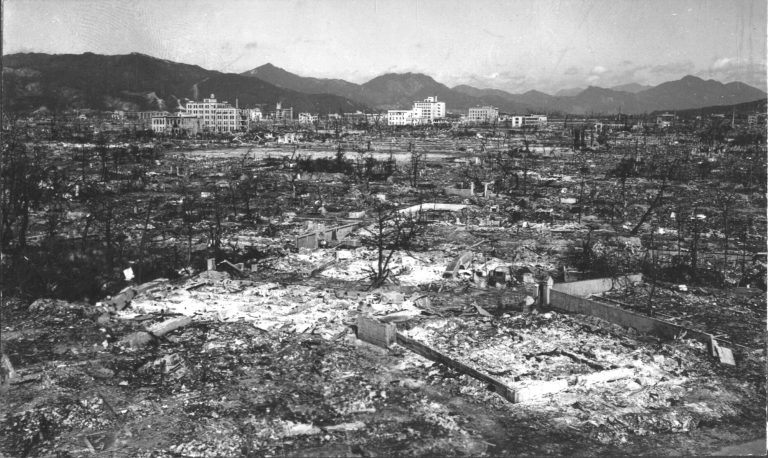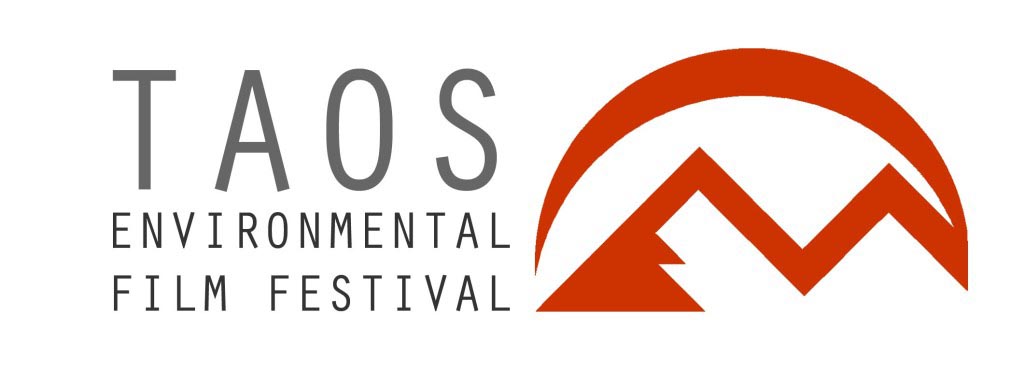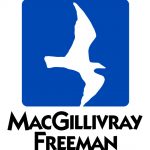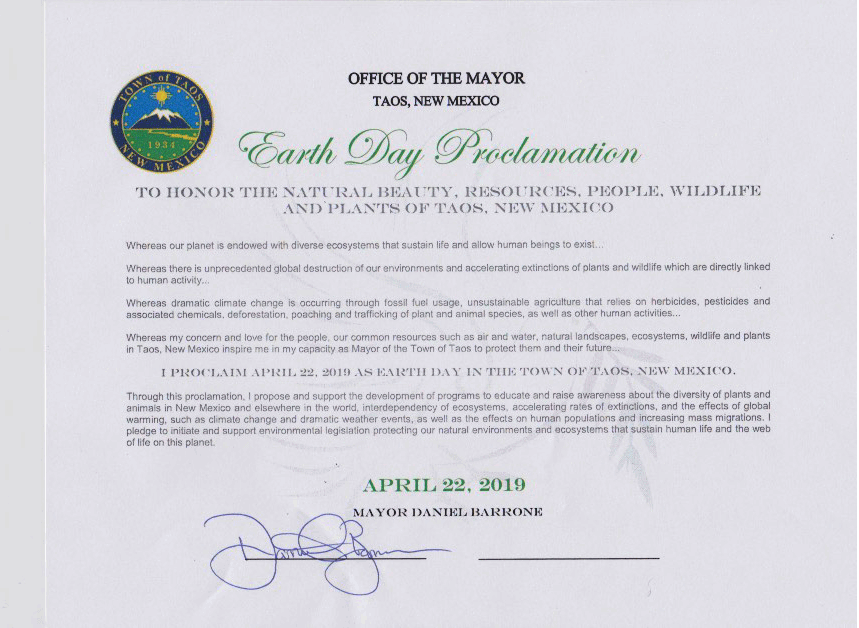Important Stuff
Jean Stevens – Taos Environmental Film Festival Director
Dave Travis – Web Development and IT Support
10am TCA
- Half Life
- Trailer, Great Barrier
- Reef Humpback Whales
- I Am Nature
- Anthem for the Amazon
- 12m
- 1m 43s
- 39m
- 8m 21s
- 5m
4pm TCA
- A Quest for Meaning
- 88m
6pm TCA
- Too Precious to Mine
- Serengeti Rules
Total
- 9m 36s
- 84m
93m 36s
8pm TCA
- Silent Forests
- 109m
4pm TCA
- Plastic Paradise
- 95m
6pm TCA
- Hiro’s Table
- Humpback Whales
- 55m
- 39m
8pm TCA
- A Bold Peace
- Blue Heart
- 57m
- 43m 32s
4pm - TCA
- Nasario Remembers The Rio Puerco
- Four Stories About Water
- 56m
- 33m
6pm - TCA
- The Map to Paradise
- 95m
The River and the Wall
97m
4pm TCA
Walking Thunder
- 94m
6pm TCA
- Tale of a Toxic Nation
- Voices for the Amazon
- River of Gold
- Anthem for the Amazon
- 12m 30s
- 6m 03s
- 61m
- 5m
8pm TCA
- Half Life
- The Human Element
- 12m
- 76m
10am TCA
- Too Precious to Mine
- I Am Nature
- Amazing Caves
- Anthem for the Amazon
- 10m
- 8m
- 38m
- 6m
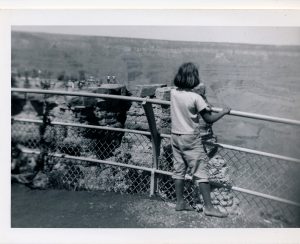
As the 5th season of the Taos Environmental Film Festival dawns, I now reflect on the year 2019 as I approach seven decades on planet Earth. Films in this 5th season of the film festival explore the many changes that have taken place in my lifetime.
When I first visited the Grand Canyon, circa 1959, there was no concern about pollution in the Colorado River and its tributaries. Little did I know that about fifty years later there would be fears of uranium mines and contamination entering the Colorado River and the precious waterfalls on the Havasupai Indian Reservation.
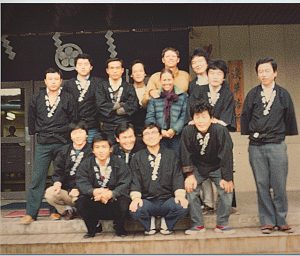
Circa 1971, I traveled to India in the era of the Indo-Pakistani War, a time before both countries possessed nuclear weapons. During the 70’s, I also traveled overland from San Diego to Costa Rica. The Vietnam War had disenchanted many youth and Costa Rica attracted travelers in search of a country without a standing army. In those days, Central America, outside of Guatemala, was generally at peace. It was another time and place, an era of “Ban the A-Bomb” and much discussion about the dangers of a “Population Bomb”.
Later, while traveling around the world in the early 80’s, I visited Japan and the Hiroshima Peace Memorial Museum. I will always remember the photographs and artwork of the devastation from the 1945 nuclear bomb attack. Now, as a result of the proliferation of nuclear bombs, we are all an endangered species.
That year I also traveled, via the Trans-Siberian Railway, across the Soviet Union. This was at the height of the Cold War and the threat of a nuclear bomb attack was real and discussed widely. Three months later, due to a Soviet miscommunication, a nuclear war was narrowly diverted.
As a result of the above experiences, in 1986, while I attended the University of California, I made a short film entitled “Hibaksha” which recorded a Japanese student reading the poetic words of a Hiroshima Hibaksha (atomic bomb survivor). The recording was saved and used in a new short film I created for the 2019 film festival, “Hibaksha Remembers”.

I am grateful for the New Yorker and their article of May 24, 2018, by Eric Schlosser, “The growing danger of the nuclear-arms race has failed to inspire much debate. Nuclear policy is no longer widely discussed in the media; the public has been told little about a subject of existential importance; and questions once passionately argued have been largely forgotten. Why do we have nuclear weapons? What they are for? How might they be used? And, at a time when a single American submarine can destroy the capital city of every country in the United Nations, how much is enough?”
Taos is 45 miles downwind from the birthplace of the nuclear bomb at the Los Alamos National Laboratory, which is built on Native American sacred land.
It is my hope that the 2019 film festival will give audiences a deeper appreciation of the natural beauty of our planet and honor its biodiversity. It is also my wish that the festival will help spread important knowledge that will assist us all to live together in a more peaceful and sustainable way.
Jean E. Stevens, MFA
She is a filmmaker, screenwriter, yoga practitioner (member of the Yoga Alliance and Sound Healers Association), artist and retired educator. In 2019 she became a Climate Reality Leader and is a member of the Northern New Mexico Chapter of The Climate Reality Project. She is also a great admirer of the climate change activist Greta Thunberg and ICAN, the 2017 Nobel Peace Prize winner, for its international campaign to abolish nuclear weapons.
Tara Waters Lumpkin, PhD
Founder and Taos resident
Tara Waters Lumpkin, PhD, Founder, Voices for Biodiversity
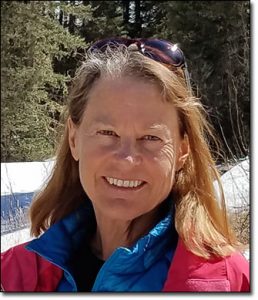
Tara is president of the non-profit Perception International. She founded Perception International's nonprofit project Voices for Biodiversity to explore, with the help of others, how human beings can shift their perceptions so as to learn to co-exist with other species and nature. In addition, she is an environmental and medical anthropologist who has worked as an international development consultant for UNICEF, the United States Agency for International Development, and a variety of nongovernmental organizations. Prior to international aid work, she was an environmental journalist and professor of writing and media, and has published poetry, fiction, and nonfiction, as well as having won more than half a dozen writing prizes, fellowships, and grants. At this time, she also is writing an eco- memoir.
VOICES FOR BIODIVERSITY
Our vision is a world where humanity and nature coexist in healthy ecological balance. Our mission is to enhance biodiversity conservation through storytelling, collaboration, community and advocacy.
Do you have a story to share about a human relationship with other species? Then join the Voices for Biodiversity (V4B) story-sharing community ... and be heard!
Voices for Biodiversity is a conservation-oriented nonprofit that connects people from around the world to protect biodiversity. Voices for Biodiversity’s multimedia digital platform builds community around global story-sharing, creating a gathering place for those who believe humanity’s health and well-being depend upon the health and well-being of other species.
Voices for Biodiversity focuses on sharing the voices of people everywhere, many are from those who usually would not be heard — indigenous and local peoples, students, non-experts, and more. Anyone can submit content and be published. For those not sure of their capabilities in writing and other multimedia forms, V4B is able to assign an eco-reporter who will help you share your story.
The Voices for Biodiversity concept began in 2009 when anthropologist Dr. Tara Lumpkin was studying how human nature affects Mother Nature. How people perceive, think and feel (personal philosophies and group cultures) affects how people interact with other species and ecosystems. Dr. Lumpkin thought: What better way to make people aware of this reality than through the ancient art of storytelling? And so, Voices for Biodiversity was born.
Great stories — those that not only inform but also provoke and inspire — are rare. Voices for Biodiversity’s stories help readers answer these questions:
How do my actions affect wildlife and biodiversity near me?
What can I do to improve the world for other species?
How can my story help connect the human animal with the global ecosystem?
Once engaged, Voices for Biodiversity’s storytellers and readers often move on to work in biodiversity advocacy, monitoring and action, scientific research, teaching, writing and photography. Some members go on to higher education while others switch to environmental careers. All are part of a worldwide community speaking out for biodiversity.
Patagonia Works
November 28, 2018 by Tessa Byars (Slightly modified by TEFF)
Patagonia is giving away the $10 million in unplanned cash we saw as a result of last year’s irresponsible tax cut. A tax cut that was not only a windfall for the oil and gas industry but will also open up 1.5 million acres on the coastal plain of the Alaska National Wildlife Refuge for oil and gas exploration and drilling. The timing of this tax cut couldn’t have been worse.
Our planet is in peril because of human-caused climate disruption. Patagonia believes the scientists—including the authors of Friday’s National Climate Assessment report—and it is urgent that we all do something about it.
Since 1985, Patagonia has funded grassroots activism as part of our commitment to 1% for the Planet. This additional $10 million will go a long way for the groups defending our air, water and land. It will also include support for the regenerative organic agriculture movement, which we think will not only slow the climate crisis but could begin to reverse it.
Patagonia’s founder, Yvon Chouinard, says catastrophe is here, and we need all the help we can get to address the climate crisis. He said, “Our government continues to ignore the seriousness and causes of the climate crisis. It is pure evil. We need to double down on renewable energy solutions. We need an agriculture system that supports small family farms and ranches, not one that rewards chemical companies intent on destroying our planet and poisoning our food. And we need to protect our public lands and waters because they are all we have left.”
Patagonia's Mission Statement:
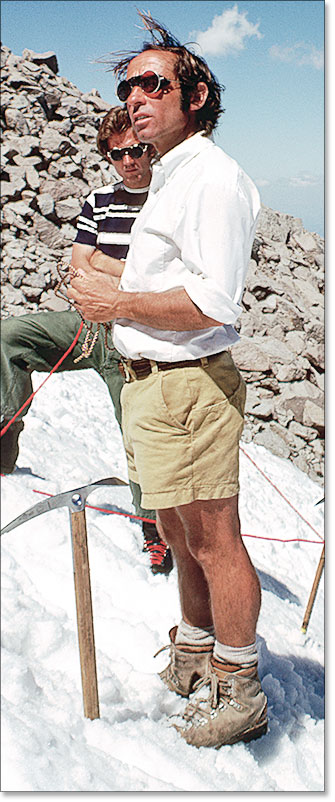
Founded by Yvon Chouinard in 1973, Patagonia is based in Ventura, California. A certified B Corp, Patagonia’s mission is to build the best product, cause no unnecessary harm and use business to inspire and implement solutions to the environmental crisis. The company is recognized internationally for its commitment to authentic product quality and environmental activism, contributing over $100 million in grants and in-kind donations to date.
We’re in business to save our homeplanet.
Our Reason for Being
At Patagonia, we appreciate that all life on earth is under threat of extinction. We aim to use the resources we have—our business, our investments, our voice and our imaginations—to do something about it.
Patagonia grew out of a small company that made tools for climbers. Alpinism remains at the heart of a worldwide business that still makes clothes for climbing—as well as for skiing, snowboarding, surfing, fly fishing, mountain biking and trail running. These are silent sports. None require an engine; rarely do they deliver the cheers of a crowd. In each, reward comes in the form of hard-won grace and moments of connection with nature.
As the climate crisis deepens, we see a potential, even probable end to such moments, and so we’re fighting to save them. We donate our time, services and at least 1 percent of our sales to help hundreds of grassroots organizations all over the world so that they can remain vigilant, and protect what’s irreplaceable. At the same time, we know that we risk saving a tree only to lose the forest—a livable planet. As the loss of biodiversity, arable soils, coral reefs and fresh water all accelerate, we are doing our best to address the causes, and not just symptoms, of global warming.
Staying true to our core values during forty-plus years in business has helped us create a company we're proud to run and work for. To stay in business for at least forty more, we must defend the place we all call home.
Core Values
Our values reflect those of a business started by a band of climbers and surfers, and the minimalist style they promoted. The approach we take toward product design demonstrates a bias for simplicity and utility.
Build the best product
Our criteria for the best product rests on function, repairability, and, foremost, durability. Among the most direct ways we can limit ecological impacts is with goods that last for generations or can be recycled so the materials in them remain in use. Making the best product matters for saving the planet.
Cause no unnecessary harm
We know that our business activity—from lighting stores to dyeing shirts—is part of the problem. We work steadily to change our business practices and share what we’ve learned. But we recognize that this is not enough. We seek not only to do less harm, but more good.
Use business to protect nature
The challenges we face as a society require leadership. Once we identify a problem, we act. We embrace risk and act to protect and restore the stability, integrity and beauty of the web of life.
Not bound by convention
Our success—and much of the fun—lies in developing new ways to do things.
More Important Stuff
TAOS ENVIRONMENTAL FILM FESTIVAL AND SATELITE EXHIBITON AT THE PHILIP BAREISS GALLERY
Reception Saturday, April 13 from 4 to 6pm Closing Reception, April 21 from noon to 3pm
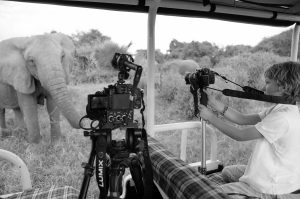 THIS EXHIBITION WILL BE IN CONJUNCTION WITH THE FILMMAKER’S BEAUTIFUL FILM, WALKING THUNDER, WHICH WILL BE SCREENED AT THE TAOS COMMUNITY AUDITORIUM ON SUNDAY, APRIL 21 AT 4PM.
THIS EXHIBITION WILL BE IN CONJUNCTION WITH THE FILMMAKER’S BEAUTIFUL FILM, WALKING THUNDER, WHICH WILL BE SCREENED AT THE TAOS COMMUNITY AUDITORIUM ON SUNDAY, APRIL 21 AT 4PM.
THE PHOTOGRAPHER’S WORK WAS SEEN AT THE COP21 - PARIS 2015 EXHIBITION. ADDRESSING CLIMATE CHANGE: LEGACY–LUCIE FOUNDATION CURATES PHOTOGRAPHY EXHIBITION HIGHLIGHTING GLOBAL CLIMATE CHANGE.
Curatorial Statement: Photography in the hands of great artists can transmit a visual message that can make an impact, like no other medium. A single still image is capable of saying something so profound that its effect is undeniably felt by all people. The artistic expression may be an individual one, but an image can be universally understood, and resonate around the world. The Lucie Awards is honored to have been asked to curate and present exceptional images that do just that.
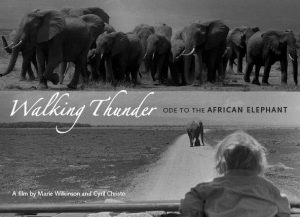 For the UN Climate Change Legacy Exhibition, we have called upon renowned photographers who have dedicated their lives to documenting melting icebergs, drought, air, water, waste pollution and the undeniable effects these things have had on our planet. It is a condensed, compassionate plea, through their lenses, of the effects of climate change.
For the UN Climate Change Legacy Exhibition, we have called upon renowned photographers who have dedicated their lives to documenting melting icebergs, drought, air, water, waste pollution and the undeniable effects these things have had on our planet. It is a condensed, compassionate plea, through their lenses, of the effects of climate change.
Their images may be startlingly beautiful, which can complicate the horrific message they convey, but look beyond the amazing artistry and try to understand the subliminal ideas within these framed works. Bravo to these brilliant image-makers who challenge us with their documentary record of what is taking place. It has been a privilege to curate their works for the COP21. We have been humbled by their clarity and consistent endeavour to keep shouting to the world to do something. Hossein Farmani, Chair, The Lucie Awards, Susan Baraz, Co-Chair, The Lucie Awards
THE MIGHTY GIRAFFE
by Lysander Christo, Writer/Photographer. Age 12
Silent steps of evolution, highest height of all the world.
Of all the world a graceful trot,
so fast, yet so slow through the savannah,
where the elephants trumpet and blow.
Your long purple tongue so strong, and so speechless
you eat the thorns of a tree of a foliage,
that resembles barbed wire fence.
If you could speak, you would tell us,
the ways of living in peace, with no menacing gaze.
If you could speak, my friend, you would tell us
how to revive ourselves, or what we have done.
We have blackened the earth and sullied our air,
we have killed your friends,
for nothing but the triumph of money
and the triumph of cash, no matter
who we are deep inside, we’re sorry for this.
Despite the commandments, despite the laws,
we have done what we wish and transformed
rainforests to deserts and savannahs to dust,
we have escaped the laws of nature,
the true laws that keep all animals from destroying the earth. From your unjudging heights
you look down upon us.
You see so much that you know the answers,
you are the messenger of knowledge itself. You are the mighty giraffe.
Published Nov. 29, 2017: BIODIVERSITY.ORG
TAOS ENVIRONMENTAL FILM FESTIVAL A SOMOS BENEFIT
CELEBRATING EARTH DAY APRIL 22 at 7pm
108 Civic Plaza Drive, Taos NM 87571 575-758-0081
Will Barnes

Will Barnes was raised in Colorado and has lived in New Mexico for 24 years. He is an ecologist and botanist, and teaches middle school language arts and science in Santa Fe, New Mexico. In 1998 and 1999, he was awarded the Academy of American Poets Prize while studying for his masters in biology at the University of New Mexico. He has recent poems in the CutBank Review and has just completed his first manuscript of poems. He lives in Santa Fe with his wife and three children and is thrilled to contribute to the Taos Journal of Poetry and Art. The Ledgerbook, with author Will Barnes’ poetry, found diary entries, and photographs, encourages a lyric exploration of landscape, memory, and identity in the American West. Drawing from the indigenous traditions of record keeping on the western plains—winter count, ledger art, diary making, letter writing, scientific description and journalism—The Ledgerbook takes the motif of writing over and on top of the stories and texts that make up the history of the American West to write its own story of identity and the experience of dissolution. These poems are lyric, ambitious, and multi-faceted. Using collage and erasure, The Ledgerbook then surely creates polyphony of voices through which a personal reconciliation of the beauty and violence of the West might take place. Underneath all of it, always, is the land itself.
Olivia Romos

Olivia Romos is a farmer, poet and water rights activist from Taos, New Mexico. She earned her dual Bachelor’s degrees in English and Chicana/o Studies from the University of New Mexico in 2015. Currently, she is the Communications and Outreach Coordinator at the New Mexico Acequia Association, a grassroots, statewide organization that defends water rights and cultivates an inter-generational movement to protect water resources and educate people about the various aspects of acequia systems. Olivia is also a recognized spoken word artist. In 2011, she was titled the New Mexico State Slam Poetry Champion. Olivia is a bilingual poet whose language is immersed in the regional Manito dialect and culture of Northern New Mexico. Olivia intentionally focuses her activism and poetry to educate and mobilize New Mexicans around the risks and uncertainties of their natural resources. She was featured in the Western Folklife Center’s poem-film Series.
Anne MacNaughton

Anne MacNaughton originated the Taos High School’s award-winning Poetry Slam Team --the first one in the nation specifically for teenagers-- and established the very first State Championship Poetry Slam for secondary students. She continues to work with youth through workshops and mentorships.
Along with the poet Peter Rabbit and eight others, she co-founded S.O.M.O.S., the Taos Poetry Circus and the Poetry Education Project, later creating the spin off non-profits Minor Heron and The World Poetry Bout Association. She still produces poetry shows through Lucid Performance, a company she started with Rabbit. https://www.lucidperformance.com/ Anne MacNaughton holds a B.A. in history and government from the University of Texas at Austin and an M.A. in English from the University of New Mexico at Albuquerque.
Her work has been published in many journals and anthologies, including The Best Poetry of 1989 (Scribners 1990), Robert Bly’s The Rag and Bone Shop of the Heart (HarperCollins 1992), and In Company: an Anthology of New Mexico Poets after 1960 (UNM Press 2004). The New Mexico Poetry Renaissance (Red Crane, 1994), The Ecstatic Moment: The Best of Libido (Dell 1997), Written with a Spoon (Sherman Asher); Thus Spake the Corpse: (Black Sparrow 2000); XY Files (Sherman Asher, 2001), Written with a Spoon (Sherman Asher, 1995)
and The Hell with Love Poems to Mend a Broken Heart (Time-Warner, 2002) among others.
Her poems have appeared in numerous literary journals, small magazines and periodicals including several volumes of Adobe Walls, Blue Mesa Review, Exquisite Corpse, The Taos Review, Libido, Crosswinds, Ant Farm,
Esprit, la Ventana, ARTlines, Taos Magazine, Seen From Space, Alma, Wordworks, The Taos News, Albuquerque Poetry Festival Anthology, 51% Magazine, Desnudas del desierto, Venus Envy, Howl, and others.
VISUAL ART
Although MacNaughton considers herself primarily self-taught, as a child she was able to study briefly under Lowell Collins on scholarship to what is now the Glassell School of Art at the Museum of Fine Arts in Houston, and in her youth she took classes now and then in various university art programs. She has participated in several group shows in Taos and her illustrations have been printed in publications from Baton Rouge to Taos. She has won several awards, including placing at Taos County Fairs in the 1980s and an honorable mention from the Museum of Fine Arts as a teenager.
Alexandra Grajeda

I have been studying herbal medicine for 8 years, with a particular interest for women's health. Incorporated in my practice are Goddess studies, a certification as a Community Herbalist from Moondance Botanicals, midwifery studies, birth-assistant trainings, traditional Mexhika healing and medicine practices, Western European herbal knowledge, Prenatal yoga, and Southwest herbal knowledge. Currently, I am an apprentice with Kalpulli Teocalli Ollin, studying curanderismo with CC Nava. I am only at the beginning of my journey; honored to have attained and remembered this plant wisdom and knowledge, as well as share it with my community. I now live in Taos, New Mexico, deeply held and in adoration of the natural world I live among.
Press April 4 THE TAOS ENVIRONMENTAL FILM FESTIVAL 2019 OFFICIAL SELECTIONS:
The Taos Environmental Film Festival is celebrating its 5th edition beginning on Thursday, April 18 to Friday, April 22. The film festival prides itself in presenting beautiful, thought provoking and award winning films by professional filmmakers who seek truth and scientific knowledge regarding our natural environment and all its inhabitants. This year the festival is excited to present films that explore and search for inner and outer peace while also exploring various natural environments, its diverse inhabitants and the challenges posed to the world’s biodiversity.
With nuclear proliferation resurfacing and a resurgence of military spending it is important that we honor the 2017 Nobel Peace Prize winner, ICAN (international campaign to abolish nuclear weapons) in their work to help our endangered species. Each year that passes it has become apparent that humanity must find a way towards world peace.
Such films as A Bold Peace, directed by Matthew Eddy and Michael Dreiling, takes the viewer to Costa Rica. It is a country that has many lessons the USA, and various countries, can learn from. The film juxtaposes the national policy of demilitarization (since 1948-49) with their investment in education, health, and the environment.
https://aboldpeace.com
TRT: 57 min; 2016
Another film, A Quest for Meaning, directed by Marc de la Menardiere and Nathaniel Coste, takes the viewer from India to Guatemala, the United States and across Europe to discover the message of activists, biologists, philosophers and guardians of ancestral traditions from across the world.
https://aquestformeaning-themovie.com/
TRT: 88 min; 2015
Plastic Paradise As a result of humankind’s massive technological and industrial revolution we are now witnessing a collective existential crisis. The multi-award winning film, Plastic Paradise, takes viewers thousands of miles away from civilization to Midway Atoll. It is one of the most remote places on earth. And yet its become ground zero for The Great Pacific Garbage Patch. Journalist/filmmaker Angela Sun travels on a personal journey of discovery to uncover this mysterious phenomenon. Along the way she meets scientists, researchers, influencers, and volunteers who shed light on the effects of our rapid plastic consumption.
https://plasticparadisemovie.com
TRT: 95 min; 2013;
The Serengeti Rules, directed by Nicholas Brown, is one of the most important but untold science stories of our time—a tale with profound implications for the fate of life on our planet. Beginning in the 1960’2, a small band of young scientists headed out into the wilderness driven by an insatiable curiosity about how nature works. Immersed in some of the most remote and spectacular places on Earth—from the majestic Serengeti to the Amazon jungle; from the Arctic Ocean to Pacific tide pools—they discovered a single set of rules that govern all life. These five unsung heroes of modern ecology share the stories of their adventures; reveal how their pioneering work flipped our view of nature on its head, and give us a chance to re-imagine the world as it could and should be.
https://www.theserengetirules.com
TRT: 84 min; 2018;
The Map to Paradise, directed by Danielle Ryan and James Sherwood, is an adventure- filled and spectacularly gorgeous tale about the birth of the global movement to protect the sea. From underwater worlds of ice to glistening coral sanctuaries, discover what it takes to build a movement and to create positive change. Filmed across six continents, the filmmakers have set out to challenge the mainstream narrative of hard-hitting environmental documentaries with a “doom and gloom” message and replace it with one of hope and courage. Along the way, we meet a prince, a president, a pirate, and also an island chief—among others—who are all playing a role in the quest to save the planet.
https://www.themaptoparadise.com
TRT 95 min; 2018;
Hiro’s Table, directed by Taos resident Lynn Hamrick is a documentary portrait of master chef Hiroli Obayashi and his wife Yasyo over a sixtenn-year span as they managed the day to day operation of their intimate Mom and Pop restaurant, Hirozen Gourmet, nestled in the unlikely corner of a West Hollywood strip mall. The film is a tribue to the subtleties of Hiro’s unique culinary vision and the perseverance it took for his family to transition from immigrant business owners to established restauranteurs with all the joys and sorrows that entailed. Like many of the small eateries in hidden spots in Los Angeles championed by Jonathan Gold, Hirozen Gourmet had a loyal following of regulars, foodies, chefs and food critics who are interviewed in the film.
https://hiros-table.com
TRT: 55min; 2018
Humpback Whales directed by Greg MacGillivray and narrated by two-time Golden Globe nominee Ewan McGregor is an extraordinary journey into the mysterious world of one of nature’s most awe-inspiring marine mammals. Set in the spectacular waters of Alaska, Hawaii and Tonga, this ocean adventure offer audiences an up close look at how these whales communicate, sing, feed, play and take care of their young. Humpbacks are found in every ocean on earth and were nearly driven to extinction 50 years ago, but today are making a slow but remarkable recovery. Join a team of researchers as they unlock the secrets of the humpback and find out why humpbacks are the most acrobatic of all whales, why they sing their haunting songs, and why these intelligent, 55-foot, 50- ton animals migrate up to 10,000 miles round-trip every year.
https://macgillivrayfreeman.com/project/humpback-whales/
TRT: 39 min; 2015
Journey into Amazing Caves A scientific exploration into some of the world’s most remote, unexplored caves, Journey into Amazing Caves, directed by Stephen Judson, follows the story of two cavers, Dr. Hazel Barton and Nancy Aulenbach, as they search for extreme living organisms in the ice caves of Greenland, the underwater caves of the Yucatan Peninsula, and the earth caves of the Little Grand Canyon.
https://macgillivrayfreeman.com/project/journey-into-amazing-caves
TRT: 38 min; 2001
The River and the Wall A spectacularly photographed film is The River and the Wall, directed by Ben Masters. The film follows five friends on an immersive adventure through the unknown wilds of the Texas borderlands as they travel 1,200 miles from El Paso to the Gulf of Mexico on horses, mountain bikes, and canoes along the Rio Grande River. Conservation filmmaker Ben Masters realizes the urgency of documenting the last remaining wilderness in Texas as the threat of new border wall construction looms ahead. Masters recruits NatGeo Explorer Filipe DeAndrade, ornithologist Heather Mackey, river guide Austin Alvarado, and conservationist Jay Kleberg join him on the two-and-a-half month journey down 1,200 miles of the U.S.-Mexico border. They set out to document the borderlands and explore the potential impacts of a wall on the natural environment, but as the wilderness gives way to the more populated and heavily trafficked Lower Rio Grande Valley, they come face-to-face with the human side of the immigration debate and enter uncharted emotional waters.
https://theriverandthewall.com
TRT: 97 min; 2018
Blue Heart Patagonia’s latest documentary film, Blue Heart, is directed by Britton Caillouette and depicts the fight to protect Europe’s last wild rivers and brings international awareness to a potential environmental disaster in Europe. The Balkan Peninsula between Slovenia and Albania is home to the last wild rivers in Europe where more than 3,000 proposed hydropower projects threaten to destroy the culture and ecology of this forgotten region. If fierce local opposition fails, 20,000 kilometers of pristine sparkling creeks, raging tributaries and swift, braided currents of the last undammed watersheds on the continent will be forever damaged by thousands of dams and diversions—at a time when dams are being decommissioned throughout much of the developed world. Local activists living along the shores of these rivers and European NGOs such as RiverWatch are fighting against government corruption and foreign investment. Blue Heart documents the battle to protect Albania’s Vjosa River, the largest undammed river in Europe; the effort to save the endangered Balkan Lynx in Macedonia, and the months-long fight by women of Kruščica,Bosnia and Herzegovina, who are protesting day and night to save their community’s only source of drinking water.
www.patagonia.com/blueheart
TRT: 43 min; 2018
Nasario Remembers is a documentary directed by Santa Fe resident, Shebana Coelho, about landscape and memory, set in the ghost towns of New Mexico’s Rio Puerco valley and featuring acclaimed oral historian Nassario Garcia. The film combines footage of Dr. Garcia and his stories amid ruins and mesas with archival photos, and lyric scenes that evoke the storytelling spirits of the valley. Together, these elements create a deeply-felt cinematic encounter between teller and tale, what is gone and what is left of memory, and coming home to the story that only you can tell. Dr. Nasario Garcia received a 2012 Lifetime Acihievement Award from the Historical Society of New Mexico for his “unparalleled” worik in the “preservation of Hispanic language, culture and folklore in New Mexico. https://www.nasarioremembers.com/home.html
TRT: 56 min; 2017
Silent Forests is directed, written and edited by Mariah Wilson. The film is an intimate portrait of conservationists and activistswho are fighting against all odds to stop forest elephant poachingin Africa's Congo Basin region. This film takes viewers to thefrontlines of conservation using an immersive, vérite-́ style approach. SILENT FORESTS is a character-driven and cinematic look at the battle for the future of the forest elephant. We take advantage of Congo and Cameroon’s natural beauty by showcasing time lapses, slider “dolly” shots, wildlife scenics, and aerials to help make this film as cinematically captivating as possible. The storyline is driven by scenes and vérité moments with our main characters. These scenes are buttressed by explanations from either on-the-fly interviews or sit-down interviews with those characters, who speak to the big picture of what is happening right now in the central Africa... and what is at stake if they aren’t able to halt this ivory highway.
TRT: 109 min; 2018
The Human Element We humans are a force of nature. At the same time human activities alter the basic elements of life-earth, air, water, and fire- those elements change human life. The Human Element is an arresting new documentary from the producers of Racing Extinction, The Cove and Chasing Ice,environmental photographer James Balog captures the lives of everyday Americans on the front lines of climate change. With rare compassion and heart, The Human Element’scoast- to-coast series of captivating stories inspires us to reevaluate our relationship with natural world.
https://thehumanelementmovie.com
TRT: 76 min 2018
Dii’go to Baahaane: Four Stories About Water (accents on Navajo words not present due to keyboard) Co-Directed by Deborah Begel (reports for New Mexico’s KSFR) and David Lindblom (Northern NM Community College Media Arts Professor), Navajo with English subtitles. This documentaryis a four part meditation on the Navajo people’s problems with contaminated drinking water. Four Stories About Water opens with a waterfall of people who reveal the scope of water contamination problems on Navajo lands, from the health problems that were likely caused by uranium tailings left uncovered to the view of water as “a spiritual element’ to the fact that 30% of the Navajo people don’t have access to safe water. 2012,
TRT: 33 min.
Too Precious to Mine, 2017, director Justin Clifton. The Grand Canyon is an irreplaceable natural treasure that draws over 5.5 million visitors to the park each year. Yet, irresponsibly operated uranium mines located on federal public land just miles from the North and South Rims threatens to permanently pollute the Grand Canyon landscape and the greater Colorado River.
TRT: 10 min.
Tale of a Toxic Nation, 2012, Director, Louis Berry. It is the story of a nation rich in resources but weak in political influence. The Navajo Reservation has been left with over 500 abandoned uranium mines, toxic surroundings and an impossible clean up. The story has never been more relevant under an administration threatening to restart uranium mining.
TRT: 13 min; 2018
Half Life: The Story of America’ s Last Uranium, Director: Justin Clifton. In southeastern Utah, not far from many of America’s famed national parks, lies America’s last remaining uranium mill. After more than 36 years in operation, the leaders of the nearby Ute Mountain Tribe’s White Mesa community worry that las regulations and aging infrastructure are putting their water supply, and way of life, at risk.
TRT:12 min; 2016
Walking Thunder, Directed by Santa Fe residents, Cyril Christo & Marie Wilkinson and narrated by their son Lysander. The filmmakers travel with their young son Lysander across East Africa, filming over the course of ten years as they observe the role of the elephant and its own rapidly changing reality. Walking Thunder presents a unique way of engaging a broad audience on these topics, telling a story through a family’s perspective and a child’s eyes. The directors have published photography books and articles, and have lectured and exhibited artwork on the subject internationally- but they see documentary as a way to engage audiences on a wider scale and with greater emotional impact.
TRT: 94 min; 2018
I Am Nature, directed by Elke Duerr who divides her time between New Mexico, Montana and Europe. I Am Nature : You are human nature, nature in human form. You humans are the outside Earth, animated Earth. What befall one us, befalls us all. Now the time has come for reciprocity, for caring for me and yourselves, for giving and receiving, for healing All Life on this planet.
TRT: 8 min; 2019
Anthem for the Amazon, Anthem for the Amazon is a collaboration to unite the world in a compelling call to action to save the world’s greatest rainforest through the universal language of music. 500 children from 50 different countries around the world came together to sing this global anthem and stand up for the Amazon rainforest. We hope you’ll sing along with them.
Amazon Aid Foundation
TRT 5 min 6min
Hibaksha Remembers, directed by Jean E Stevens. Hibaksha was a nuclear attack victim. This short film, "Hibaksha Remembers", uses the words of a young poet who witnessed the bomb drop from the sky on the morning of August 6, 1945. It was a beautiful morning filled with youthful innocence, a blue sky and flowers that blossomed with the fruits of summer. It took less than a minute for this idylic scene to become a nightmare inferno. It is my hope that this film will help support the efforts of ICAN, the winner of the 2017 Nobel Peace Prize. ICAN's mission is to rid the world of nuclear bombs forever. 2019,
TRT 7min
An Earth Day Proclamation by the Governor of New Mexico and the Mayor of Taos will be read at the beginning and during the film festival, which is April 22, 2019.
“In nature nothing exists alone.” Rachel Carson
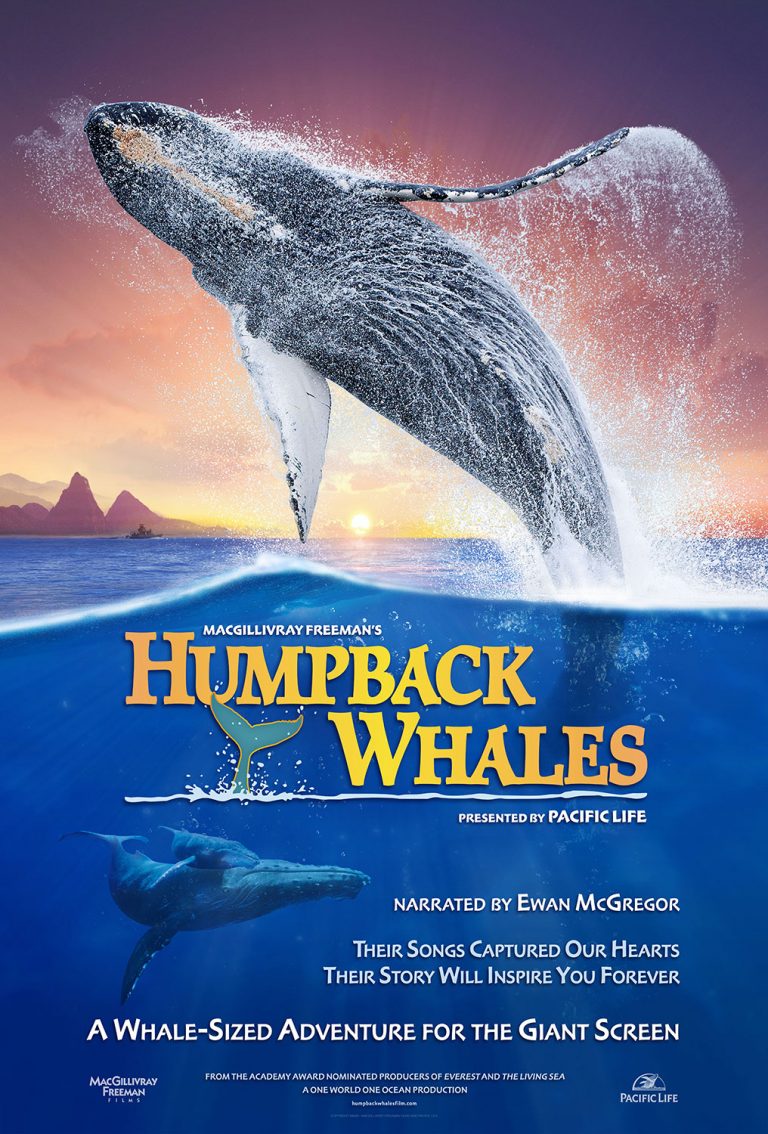
Humpback Whales
Director: Greg MacGillivray
Web site: www.humpbackwhalesfilm.com
TRT: 39m
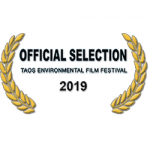 Narrated by two-time Golden Globe® nominee Ewan McGregor, is an extraordinary journey into the mysterious world of one of nature’s most awe-inspiring marine mammals. Set in the spectacular waters of Alaska, Hawaii and the remote islands of Tonga, this ocean adventure offers audiences an up-close look at how these whales communicate, sing, feed, play and take care of their young. Captured for the first time with IMAX® 3D cameras, and found in every ocean on earth, humpbacks were nearly driven to extinction 50 years ago, but today are making a slow but remarkable recovery. Join a team of researchers as they unlock the secrets of the humpback and find out why humpbacks are the most acrobatic of all whales, why they sing their haunting songs, and why these intelligent, 55-foot, 50-ton animals migrate up to 10,000 miles round-trip every year.
Narrated by two-time Golden Globe® nominee Ewan McGregor, is an extraordinary journey into the mysterious world of one of nature’s most awe-inspiring marine mammals. Set in the spectacular waters of Alaska, Hawaii and the remote islands of Tonga, this ocean adventure offers audiences an up-close look at how these whales communicate, sing, feed, play and take care of their young. Captured for the first time with IMAX® 3D cameras, and found in every ocean on earth, humpbacks were nearly driven to extinction 50 years ago, but today are making a slow but remarkable recovery. Join a team of researchers as they unlock the secrets of the humpback and find out why humpbacks are the most acrobatic of all whales, why they sing their haunting songs, and why these intelligent, 55-foot, 50-ton animals migrate up to 10,000 miles round-trip every year.
A MacGillivray Freeman film presented by Pacific Life, Humpback Whales is directed by Greg MacGillivray (The Living Sea, Dolphins, Everest) and produced by Shaun MacGillivray (To The Arctic, Grand Canyon Adventure). Filmed with 15perf / 65mm IMAX® cameras, Humpback Whales is written and edited by Stephen Judson (Everest, To The Arctic) with a musical score by Steve Wood. (Journey to the South Pacific, To The Arctic). A One World One Ocean production.
MacGillivray Freeman Films is the world’s leading independent producer and distributor of giant-screen 70mm films with 38 films for IMAX theatres to its credit. Throughout the company’s 50- year history, its films have won numerous international awards including two Academy Award®nominations and three films inducted into the IMAX Hall of Fame. Humpback Whales follows in the company’s long tradition of films known for their artistry and celebration of science and the natural world.
ABOUT THE PRODUCTION
MacGillivray Freeman Films (MFF) bring their exhilarating giant-screen storytelling to one of the most enormous and vastly fascinating creatures on earth in Humpback Whales – an immersive ocean adventure that invites audiences to dive head-first into the mysterious realm of these 55-foot, 50-ton aquatic mammals. In a splashing, exuberant, musical mix of 3D imagery, underwater splendor and scientific exploration, the film beckons the compelling question: what might life be like from a humpback POV?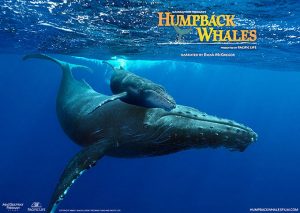
Narrated by two-time Golden Globe® nominee Ewan McGregor (Star Wars Episode I: The Phantom Menace, Salmon Fishing in the Yemen) and presented by Pacific Life, it’s a whale of a tale that begins with promising news. Once feared as monsters, and very nearly hunted to extinction, today humpbacks appear to be in the midst of a slow but remarkable recovery. Now protected by global bans on whaling, the image of the humpback has transformed 180 degrees into a wellspring of wide-eyed human curiosity, passion and inspiration. The result has been a golden age of cetacean science now tackling the many puzzles of their intriguing behaviors.
Splashing right into this exciting new era, Humpback Whales tags along with leading whale researchers using pioneering methods to better understand what whales do when no one’s watching. As the film sails from the tropical Kingdom of Tonga to lush summertime Alaska to the invitingly warm waters of Hawaii, moviegoers have the chance to follow along on the humpback’s epic migration, while experiencing its devoted bonds, amazing songs and underwater acrobatics.
In some of MFF’s most movingly intimate footage – as intimate as you can get with a 50-ton seafarer – the humpbacks croon their long, complex songs, raise their jumbo-sized babies, display their acrobatic feats, work in cooperative teams and chase one another in high-speed competitions. It all leads up to an edge-of-your-seat whale rescue – and an unforgettable reminder that the future of whales depends in large part on us humans allowing them to sing their own tune.
A MacGillivray Freeman film presented by Pacific Life, HUMPBACK WHALES is directed by Greg MacGillivray (The Living Sea, Dolphins, Everest) and produced by Shaun MacGillivray (To The Arctic, Grand Canyon Adventure). Filmed with 15perf / 65mm IMAX® cameras, HUMPBACK WHALESis written by Stephen Judson (Everest, To The Arctic) with a musical score by Steve Wood (Journey to the South Pacific, To The Arctic). A One World One Ocean production.
Journey into Amazing Caves
Director: Stephen Judson
Web site: www.amazingcaves.com
TRT: 38m
 All over our planet there are landscapes that hold caves beneath them. Challenged by the underground frontier and inspired by the secrets it may yield, cavers share a passion for exploration. Journey into Amazing Caves follows Hazel Barton and Nancy Aulenbach on an adventure to explore caves in canyon walls, in glaciers and beneath the rainforests of Mexico. In these unusual and hostile places, Barton, a microbiologist, searches for tiny organisms that somehow survive there. The microorganisms that live in environments with no light, few nutrients, and in the case of glaciers, locked in ice for hundreds or thousands of years, have developed unique survival tactics and lethal weapons against other organisms that compete for the same, few nutrients. Barton studies this subterranean life in hopes it may point to new drugs or antibiotics to fight human illness
All over our planet there are landscapes that hold caves beneath them. Challenged by the underground frontier and inspired by the secrets it may yield, cavers share a passion for exploration. Journey into Amazing Caves follows Hazel Barton and Nancy Aulenbach on an adventure to explore caves in canyon walls, in glaciers and beneath the rainforests of Mexico. In these unusual and hostile places, Barton, a microbiologist, searches for tiny organisms that somehow survive there. The microorganisms that live in environments with no light, few nutrients, and in the case of glaciers, locked in ice for hundreds or thousands of years, have developed unique survival tactics and lethal weapons against other organisms that compete for the same, few nutrients. Barton studies this subterranean life in hopes it may point to new drugs or antibiotics to fight human illness
High on a cliff near the Grand Canyon, Dr. Hazel Barton and Nancy Aulenbach rappel down to a cave entrance, dangling more than 700 feet above a turquoise-hued river. They aim to be the first to explore a little-known cave formed millions of years before the river cut through the canyon.
In Greenland, Barton and Aulenbach join a team of scientists and adventurers who are attempting a record depth – 500 feet — into a glacier ice cave. They descend dramatic surface crevasses into a cathedral-like world of blue ice. Razor-sharp ice shards fall from the glacier walls. As Nancy studies how these caves are formed, Hazel collects tiny organisms that can survive extreme pressures and temperatures. These organisms are in suspended animation and can be brought back to life when removed from the ice.
The underwater caves of Mexico’s Caribbean coast contain the beautiful formations found in typical, terrestrial caves. In the film, the water is so clear, you won’t know you’re underwater until you see Hazel in Scuba gear. These caves are beautiful, but dangerous. One wrong move by a caver here can be deadly. Beneath the Mayan jungle, Hazel searches underwater cave passages for microorganisms living in the shimmering halocline: where the freshwater that flows eneath the jungle meets the ocean saltwater.
As it conveys the excitement of scientific exploration, Journey into Amazing Caves takes audiences on an adventure in the natural world…to the underground landscapes that are as beautiful and vital as any place on Earth.
Rigging a Canyon Cave
It was no surprise to MacGillivray Freeman’s film crew that the cave in Little Colorado River Canyon had never been explored. Not only were there no roads to this location, the cave was on a cliff 300 feet below a plateau and more than 700 feet above the river. The ‘easiest’ way into the cave was from the plateau above. Helicopters flew the 30-person crew and 3-1/2 tons of gear to and from the site each day.
A team of expert riggers devised a 20-foot truss and winch that lowered crew and equipment down the sheer cliff to the cave entrance. MFF trusted this venture to rigger and production manager Earl Wiggins whose last job was overseeing the safety of Tom Cruise in Mission Impossible 2. Director of Photography Brad Ohlund was impressed with the result: “Not only did Earl and Mark Chapman build a system for getting people and gear into an impossible location, they created shooting platforms in no time flat. I just had to show them where I wanted the lens, and literally, only minutes later, the camera and tripod would be rigged solid.” He continued, “They quickly understood that in IMAX, we always need to put the camera where it doesn’t want to go.”
Surviving Greenland’s Ice Caves
“There were certainly major technical challenges shooting IMAX footage in the vertical ice shafts of Greenland, but nothing of any technical nature even approached the sheer magnitude of sitting on three thousand feet of ice, or realizing at the bottom of one of the ice caves that we were not even a fifth of the way to bedrock, ” said Cinematographer Gordon Brown.
The most difficult shots were deep within Minnik, the near 600-foot ice cave. The crew needed to set up a platform close to the bottom of the cave to film the characters’ descent. At this depth, the ice is under 300 pounds of pressure per square inch, making the ice walls very unpredictable. On one ascent, when a crew member merely kicked the ice wall with his crampons to get a hold, a 100-foot crack rifled across the face of the walls above them. Though the film and caving team tried their best to purge the icy shaft of icicles, they realized even the smallest of loose shards could prove dangerous, even deadly, if they plummeted hundreds of feet to the crew below.
The falling ice caused the crew to abandon the filming platform and move to a 9600 pound ice block, wedged precariously in the shaft, but just around the corner from the platform and out of the way of falling ice. As the film team used ice screws to secure their position, they heard another sharp snap as the block beneath them shifted a quarter-inch. They watched a crack move in slow motion up the wall for about 40 feet. The block shifted another quarter inch. Continues Brown, “The disturbing part was that the ice block did not settle or roll, but continued to grind away at its trappings a quarter inch at a time. Every five minutes our hearts stopped as we felt our footing shudder and we heard an awful snap and grind. There wasn’t anything to do but keep shooting.”

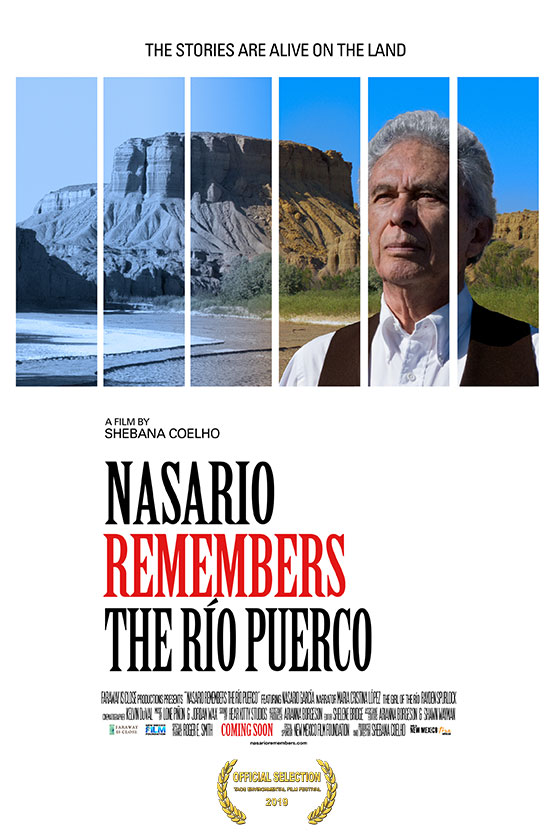
NASARIO REMEMBERS THE RÍO PUERCO
Completion Date: October 12th 2017
Dubbed by: Dr. Gacrcía
Release Year: 2017
Nominated BEST DOCUMENTARY – New Mexico Filmmakers Showcase
Nominated BEST LATIN SONG “Indita del Río Puerco” – New Mexico Music Awards
Returning to the ruins of a remote valley where he grew up, New Mexico folklorist Nasario García unearths memories of a time before the rains stopped, when the Hispanic villages flourished with stories of land, river, animals, magic and myth.
The story of Nasario remembers the Río Puerco begins with a cante jondo, a song that Nasario García hears in Andalucía, Spain in the 1960s that triggers memories of his chilhood in a small village in New Mexico. This moment inspires his life’s work, which has now spanned four decades, as an acclaimed folklorist and oral historian chronicling the life and stories of this isolated valley in the American Southwest. Nestled among mesas and extinct volcanoes, southeast of Chaco Canyon, and adjoining Navajo and Pueblo communities, the Hispanic villages of this valley bloomed in isolation from the 1900s to 1950s. Their origins, language and culture reflected the intersection of influences from Spain, Mexico and Native communities that are part of New Mexico’s past and present.
In the documentary, Nasarío remembers the Río Puerco, Dr. García lets the landscape speak through him in story, silence and song as he wanders through the now ghost towns of his youth.
The film’s narrative mirrors how memory creates an eternal present. Every time Nasario returns to the ruins, the story begins and ends again. With eloquence and humor, he guides us into memories of his childhood and the lives of early settlers like his grandparents and parents who ranched and farmed the land. He takes us on adventures, from threshing pinto beans to encounters with hawks and bears, Sunday rituals and Christmas horse rides, twilight stories of witches, magic and enchanted mesas, racing the river after thunderstorms, and eventually, the arrival of droughts. The family’s departure to the city ends the story when Nasario is nine – till it begins again, many years later, when he is in his twenties and hears a song far from home.
The cinematography captures the dramatic hues, light and expanse of the desert. Archival photos and brief dramatic sequences evoke the storytelling spirits of the valley. The soundtrack features cante jondo and oud compositions, New Mexico roots music, Mexican ballads and an original song, the “Indita del Río Puerco.” Together, these elements create a deeply-felt cinematic encounter between teller and tale, what is gone and left of memory, and coming home to the story only you can tell. In its celebration of oral storytelling traditions, the film also offers an invitation for audiences to stop and listen to their own stillness, to a place from long ago that waits in the soul.
River of Gold
TRT: 56m
RIVER OF GOLD is the disturbing account of a clandestine journey into Peru’s Amazon rainforest to uncover the savage unraveling of pristine jungle. Ron Haviv and Donovan Webster, two war journalists, led by Peruvian Enrique Ortiz, bear witness to the apocalyptic destruction in the pursuit of illegally mined gold with consequences on a global scale. Flash forward four years to a massive intervention by the Peruvian government. What will be the fate of this critical region of priceless biodiversity as these extraordinarily beautiful forests are turned into a hellish wasteland?
RIVER OF GOLD • PRODUCTION NOTES
By Sarah duPont, Co-Director/Producer
In the summer of 1999, I journeyed to the Peruvian Amazon, a remote and pristine area, the largest piece of contiguous rainforest left on the planet. There we meandered along undulating brown rivers by boat, the best way to traverse this dense and roadless place. I was traveling with an intrepid group of scientists. Our destination was the research station we had built to study and protect this critical ecosystem. I came to learn firsthand how the Amazon is one of the most important places for the stability of our environment; not only is the Amazon an untapped plethora of important species, it also houses countless trees that keep the world’s weather patterns steady.
Since that time, I have been fortunate to travel back to the jungles of the Amazon. But it has become a different place. Roads have been built and people have arrived. It has become a new wild west, a place without law. People driven by poverty and the desire for a better life have come, exploiting the sacred ground. Almost 10 years after my first trip to the once pristine Amazon, I could no longer travel the rivers without witnessing mass ecological destruction. In desperation, I gathered a team of some of the best scientists, environmentalists, and artists to document this tragedy. I wanted to create a film that is both beautiful and informative; one that I hope will affect the audience so that they too can step forward to protect the Amazon and ensure that the future climate of the world is as we know it today.
But how was I to deliver this message? How could I get people to pay attention in this chaotic time? For me, I knew that it felt like war. A war against the environment. Ecocide. Then a thought was born. Why not make a documentary that follows journalists who specialize in war reportage, filming them as they witnessed this broad, far reaching, and criminal eradication of the Amazon? This film would capture this war against nature.
RIVER OF GOLD was indeed a very difficult and dangerous film to make. As the producer I was at times very concerned for the safety of the team. We were documenting places where outsiders are never allowed. The stakes were high and we knew that filming illegal mines would not be welcomed. Moments of the shoot were thick with tension; we were skirting danger, not knowing if we would be able to complete our mission successfully and safely. But thanks to our courageous and talented crew, we came home with 26 hours of horrible, poignant, yet beautiful imagery for the world to see. We can now all witness young men standing in barrels laden with mercury, child prostitution and slavery, and the majestic trees once filled with the joyous songs of birds now turning into desolate and toxic soil all gone in the quest for gold.
And what is this destruction worth? Does the sparkling superfluous glitter of gold outshine all other necessary elements of life? This beautiful and intricate web of life that we have been given to nourish our bodies and souls is being destroyed. And for what?
Humans have the capacity for greatness and the ability to create solutions. I believe in grace. RIVER OF GOLD was made in the hope for a safe and healthy world.
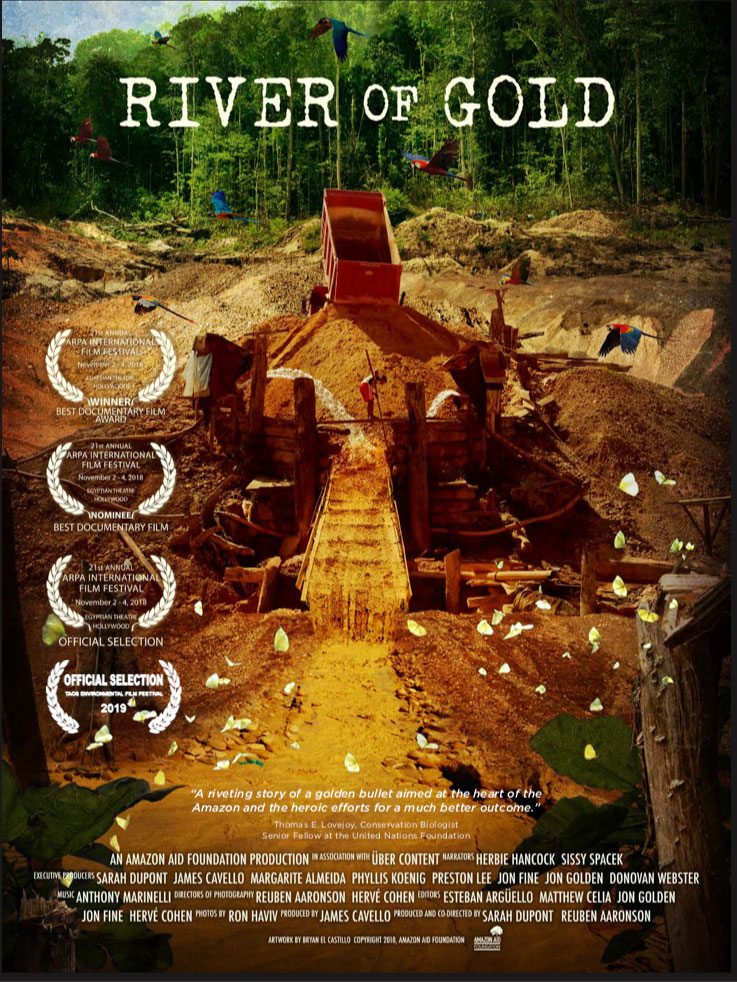

Silent Forests
SILENT FORESTS
Website: www.silentforests.com
TRT: 109m
SILENT FORESTS is an intimate, character-driven portrait of conservationists and activists who are fighting against all odds to stop forest elephant poaching in Africa’s Congo Basin region. After a study revealed that more than half the central African forest elephant population has been lost to poaching in the last decade, there has been a concerted effort to save those that remain. SILENT FORESTS will explore this story through a range of dynamic subjects; including one of Cameroon’s first female eco-guards, a grassroots wildlife law enforcement group, a Congolese biologist studying elephant behavior, a reformed elephant poacher, and a team of anti-poaching sniffer dogs led by a Czech conservationist. As passionate and tenacious as these conservationists are, they are up against huge institutional challenges like corruption and lack of funding that threaten to derail all their attempts to fight for the future of the forest elephant.
Blue Heart of Europe
An Amazon Aid Foundation Production
Trailer: https://blueheart.patagonia.com/
Total Run Time: 97 min
Release Year: 2018
Taos Environmental Film Festival in association with Amazon Aid Foundation, present River of Gold. River of Gold tells of The Fight for Europe’s Last Wild Rivers.
Patagonia’s latest documentary film, Blue Heart, depicts the fight to protect Europe’s last wild rivers and brings international awareness to a potential environmental disaster in Europe. The Balkan Peninsula between Slovenia and Albania is home to the last wild rivers in Europe where more than 3,000 proposed hydropower projects threaten to destroy the culture and ecology of this forgotten region. If fierce local opposition fails, 20,000 kilometers of pristine sparkling creeks, raging tributaries and swift, braided currents of the last undammed watersheds on the continent will be forever damaged by thousands of dams and diversions—at a time when dams are being decommissioned throughout much of the developed world.
Local activists living along the shores of these rivers and European NGOs such as RiverWatch are fighting against government corruption and foreign investment. Blue Heartdocuments the battle to protect Albania’s Vjosa River, the largest undammed river in Europe; the effort to save the endangered Balkan Lynx in Macedonia, and the months-long fight by women of Kruščica, Bosnia and Herzegovina, who are protesting day and night to save their community’s only source of drinking water.
“With the deluge of proposed hydropower dams and diversions in the Balkan Peninsula we are looking at what could be irreversible environmental destruction, but there is very little awareness of this issue in Europe or globally,” stated Ryan Gellert, Patagonia General Manager, EMEA. “We hope that this film will bring international attention to the local communities fighting to protect the free-flowing rivers they rely on and educate people about why hydropower dams are an outdated, dirty technology.”
“I believe this wild place requires and deserves protection. To destroy it, especially for an outmoded and expensive technology, is a waste of money and a moral travesty,” says Yvon Chouinard, Patagonia, Inc. founder
Created by Patagonia, in partnership with NGOs from across the Balkan region and throughout Europe and directed by Britton Caillouette, the film is a powerful moment in the larger ongoing effort to raise global awareness for the Save the Blue Heart of Europecampaign. In the film and throughout the campaign, Patagonia asks people to act now and sign an online petition to put pressure on foreign developers and banks, who are funding dam-building projects, including within protected areas.
Blue Heart launches globally on 28 April 2018. The world premiere of the film will be held at Idbar Dam, Konjic, in Bosnia and Herzegovina, followed by screenings across the Balkan Peninsula and in major cities worldwide.
About Patagonia
Founded by Yvon Chouinard in 1973, Patagonia is an outdoor company based in Ventura, California. A Certified B Corp, Patagonia’s mission is to build the best product, cause no unnecessary harm and use business to inspire and implement solutions to the environmental crisis. The company is recognized internationally for its commitment to authentic product quality and environmental activism, contributing $90 million to date in grants and in-kind donations.
About Patagonia
Founded by Yvon Chouinard in 1973, Patagonia is an outdoor company based in Ventura, California. A Certified B Corp, Patagonia’s mission is to build the best product, cause no unnecessary harm and use business to inspire and implement solutions to the environmental crisis. The company is recognized internationally for its commitment to authentic product quality and environmental activism, contributing $90 million to date in grants and in-kind donations.
About the director
Britton Caillouette has been making films in the outdoors for over a decade. A student of history with a keen eye for photography and a love for challenging production situations, he brings a unique style of visual storytelling and humanity to his stories. Britton directed his first documentary in war-torn West Africa while an undergraduate at Stanford University and has won awards for his work in both film and advertising including a Cannes Lion.
Britton Caillouette has been making films in the outdoors for over a decade. A student of history with a keen eye for photography and a love for challenging production situations, he brings a unique style of visual storytelling and humanity to his stories. Britton directed his first documentary in war-torn West Africa while an undergraduate at Stanford University and has won awards for his work in both film and advertising including a Cannes Lion.
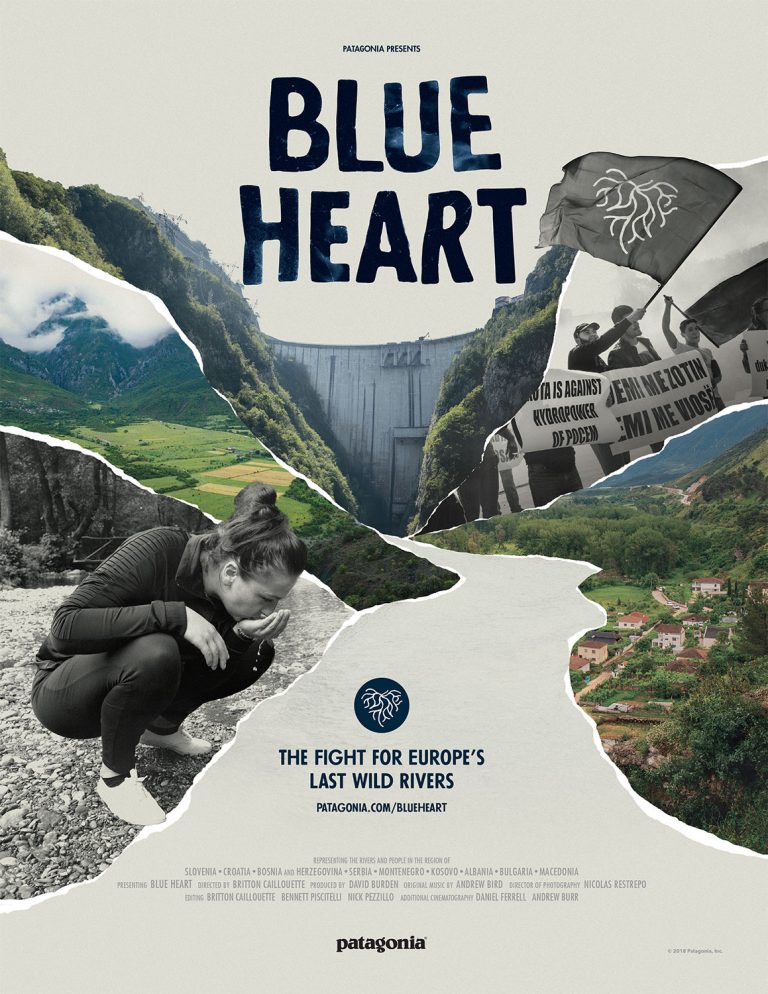

THE SERENGETI RULES
Exploring some of the most remote and spectacular places on Earth, five pioneering scientists make surprising discoveries that flip our understanding of nature on its head, and offer new hope for restoring our world.
Academy Award-winning Passion Pictures and HHMI Tangled Bank Studios present one of the most important, but untold science stories of our time—a tale with profound implications for the fate of life on our planet.
Beginning in the 1960s, a small band of young scientists headed out into the wilderness, driven by an insatiable curiosity about how nature works. Immersed in some of the most remote and spectacular places on Earth—from the majestic Serengeti to the Amazon jungle; from the Arctic Ocean to Pacific tide pools—they discovered a single set of rules that govern all life. Now in the twilight of their eminent careers, these five unsung heroes of modern ecology—Bob Paine, Jim Estes, Mary Power, Tony Sinclair, and John Terborgh—share the stories of their adventures, and how their pioneering work flipped our view of nature on its head. Across the globe, they discovered that among the millions of species on our planet, some are far more important than others. They called these species “keystones,” because they hold the natural world together.
The role of keystones is both revelatory and surprising: sea otters help kelp forests flourish, supporting everything from salmon to eagles; wolves enable rivers to run clear and help forests thrive; and the humble wildebeest controls the numbers of trees, butterflies, elephants, and even giraffes on the savanna.
Unfortunately, these deep connections also work in reverse. When keystones are removed, ecosystems unravel and collapse—a phenomenon no one had imagined—or understood until their revolutionary discoveries. But with new knowledge also comes new hope, and these same visionaries reveal the remarkable resilience of nature—and how the rules they discovered can be used to upgrade and restore the natural world. They give us the chance to reimagine the world as it could and should be.
Based on the book by Sean B. Carroll, The Serengeti Rules will forever change the way we see nature. The film will be accompanied by a media and impact campaign to shine a light on restoration projects across the world.
HIRO’S TABLE
HIRO’S TABLE is a documentary portrait of master chefHiroji Obayashi and his wife Yasuyo over a sixteen-year year span as they managed the day to day operation of their intimate Mom and Pop restaurant,
Hirozen Gourmet, nestled in the unlikely corner of a West Hollywood strip mall.
The film is a tribute to the subtleties of Hiro’s unique culinary vision and the perseverance it took for his family to transition from immigrant business owners to established restauranteurs with all the the
joys and sorrows that entailed.

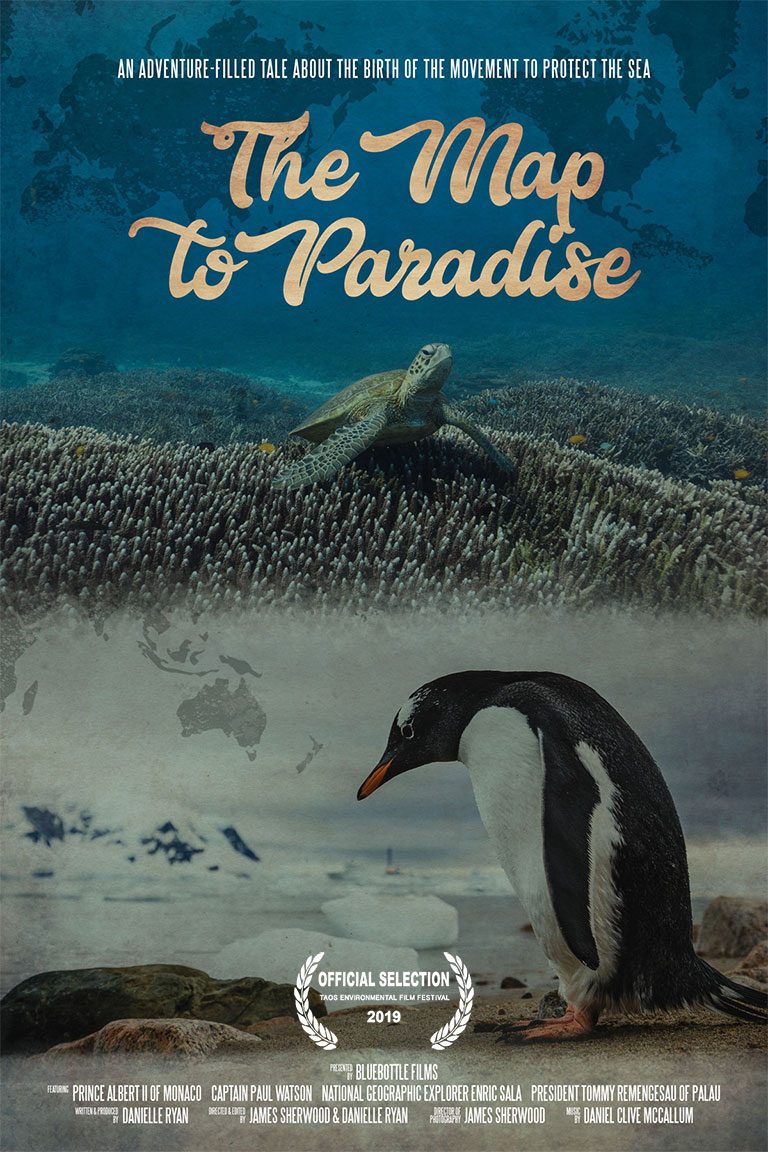
THE MAP TO PARADISE
Directors: Danielle Ryan, James Sherwood
Executive Producer: Martin Sheen
Music: Daniel Clive Mccallum
Animator: Anna Outridge
Illustrator: Mia Grimaldi
Cast: Prince Albert Ii Of Monaco, Tommy Remengesau (President Of Palau), Tony Burke (Australia’s Former Environment Minister), Enric Sala (National Geographic Explorer), Captain Paul Watson, Mario Pascobello, Ari Friedlaender, Michael Sutton, Guiseppe Notarbartolo Di Sciara, Mary Jean Samson Tabanera, Frank Talbot, Nicola Benyon, Georgios Troupis, Keobel Sakuma, Ruffino, Cindy Walter, Gerald Tuayon, Laurent Martin, Kip Evans, Pat Hutchings, Dave Gumban Alboa, John Day, Aki, Charles Littnan
TRT: 95m
THE MAP TO PARADISE is an adventure-filled and spectacularly gorgeous tale about the birth of the global movement to protect the sea. From underwater worlds of ice to glistening coral sanctuaries, discover what it takes to build a movement and to create positive change.
Filmed across six continents, the filmmakers have set out to challenge the mainstream narrative of hard-hitting environmental documentaries with a “doom and gloom” message, and replace it with one of hope and courage. Along the way, we meet a prince, a president, a pirate, and also an island chief—among others—who are all playing a role in the quest to save the planet.
Mixing colorful character-driven stories and hand-rendered animations, THE MAP TO PARADISE is a rare urgent environmental wake-up call that retains a sense of awe and wonder for the kind of beauty that is still possible.
A Bold Peace
 WRITER, DIRECTOR & PRODUCER: MATTHEW EDDY
WRITER, DIRECTOR & PRODUCER: MATTHEW EDDY
CO-DIRECTOR & PRODUCER: MICHAEL DREILING
TRT: 105m
Over 70 years ago, Costa Rica became one of the only nations in the world to disband their military and to redirect national resources towards education, health, and the environment. Since then, Costa Rica has earned the number one spot in the Happy Planet Index, a ranking of countries based on measures of environmental protection and the happiness and health of its citizens. And the World Database of Happiness, with data on 149 nations compiled by a Dutch sociologist, lists Costa Rica as number one in self-reported happiness and number one in happy life years.
A Bold Peace juxtaposes the national policy of demilitarization (since 1948-49) with their investment in education, health, and the environment. Pointed parallels and contrasts are made with recent U.S. debates over the national debt, healthcare, the environment and the escalating cost of U.S. militarism. The film features former presidents, Costa Rican government officials, as well as scholars, journalists and citizens of Costa Rica.
Unfortunately, the Costa Rican example has received very little international attention. This documentary film will bring attention to Costa Rica’s inspirational national project, answering why happiness, health, and human rights occupy a relatively prominent place in this Central American country.
- “….Every gun that is made, every warship launched, every rocket fired signifies, in the final sense, a theft from those who hunger and are not fed, those who are cold and are not clothed…” – – President Eisenhower (1953): Cross of Iron Speech
- “The army is a thing of the past. War is not normal in human life. Peace is normal.” – José Figueres (former President of Costa Rica)
- “There’s a great danger of turning society into machines who are producing goods and services and doing away with many of the spiritual aspirations of mankind.” – José Figueres (former President of Costa Rica)
- “We have shown the world that it is possible for a country like ours to live without an army.” – Oscar Arias (former President of Costa Rica and Nobel Peace Prize winner)
Chapter 1: Another Way
The film details Costa Rica’s relative success as indicated by its #1 ranking in several global surveys of happiness and its #1 ranking in the Happy Planet Index. Costa Rica’s “culture of peace” is explored as Costa Ricans explain their views on demilitarization, the value of social solidarity, and their perceptions of the cultural ethos of “Pura Vida.”
Chapter 2: The Abolition of the Military
In the early 1940s, an unusual coalition of the Catholic Church, labor leaders, and the Calderon administration pushed through progressive reforms which laid the foundation for a strong welfare state. Political corruption and electoral fraud led to the Civil War of 1948. The film explores the formation of Jose Figueres as a uniquely visionary leader and his rise to the national stage. Figueres’ decision to abolish the army was both pragmatic and idealistic. He was a self-taught man and a voracious reader of Tolstoy, Emerson, and other leading pacifists. As leader of the revolutionary Junta,
he solidified Costa Rica’s social democracy and walked away from power in order to honor that democracy.
Chapter 3: New Challenges
Costa Rica’s peace model has been put to the test several times. In the 1980s, in the face of raging Civil Wars across Central America and intense pressure from the Reagan Administration, President Monge’s Neutrality Declaration and President Oscar Arias’ Peace Plan negotiations are highlighted as bold attempts to stand for peace during a major escalation of the Cold War. A fascinating grassroots effort to remove Costa Rica from the list of the “Coalition of the Willing” at the outset of the U.S.-led Iraq War is detailed. In 2010, in a shocking provocation, the Nicaraguan Army occupied part of Costa Rica’s territory. Rather than retreat, Nicaragua doubled their forces on the border. Costa Rica diffused the crisis by appealing to the Organization of American States and
the International Court of Justice. Costa Rica’s response offers a crucial case study in international law and diplomacy.
Chapter 4: Costa Rica’s National Security Model
Costa Rican and U.S. experts reflect on Costa Rica’s 65 years without a military. Costa Rican commitments to diplomacy, international organizations, international laws and courts are detailed. The role of Oscar Arias in trying to export the Costa Rican model is also detailed. Both Panama and Haiti embraced demilitarization as a result of Arias’ efforts. Interviewees point out that the Costa Rica’s “no standing army” policy echoes Thomas Jefferson’s hope that the U.S. would have no standing army.
Chapter 5: Threats to Peace
Costa Rica is no utopia. Rising inequality in the wake of economic globalization, including neoliberal “free trade” agreements, threaten to destabilize Costa Rica’s traditions of solidarity and social democracy. And, much as in the 1980s, U.S. foreign policy – this time in the form of the Drug War – also threatens Costa Rica’s tradition of demilitarization.
Chapter 6: The Permanent Warfare State
The Costa Rican model illuminates the heavy opportunity costs and ongoing human tragedy of the U.S. military-industrial complex and permanent war economy. The U.S. defense industry, U.S. spending priorities, and U.S. diplomatic failures to support international law and UN treaties including the Arms Trade Treaty (led by the Costa Rican leader Oscar Arias) are critiqued. In the film’s conclusion, ordinary Costa Ricans read the names of 9 significant international peace and human rights treaties that Costa Rica has signed, but which the U.S. government has so far refused to sign.
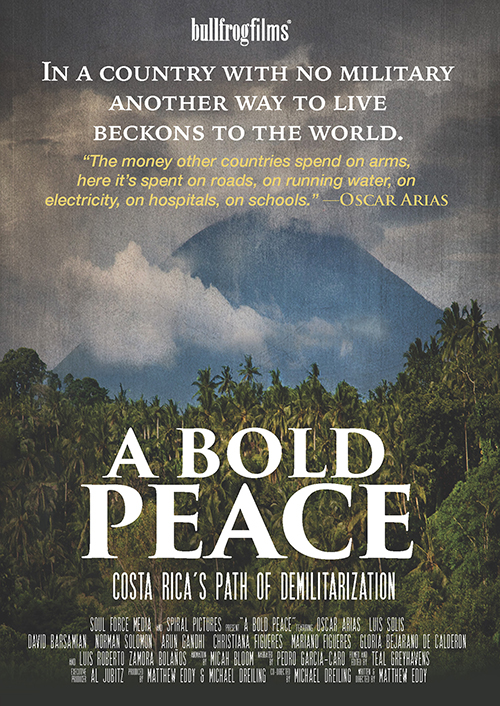
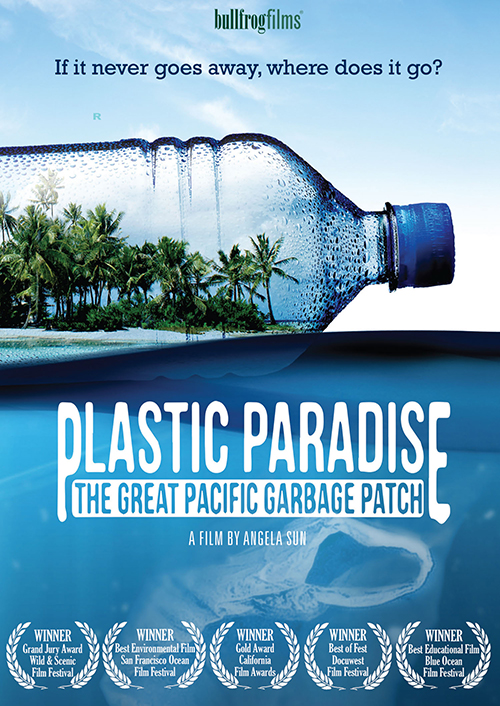
Plastic Paradise
Director: Angela Sun
Executive Producers: Gil Elbaz Elyssa Elbaz Cathy Tsang David Tsang
Cinematography by: Joseph Ochoa, Francisco Aliwalas, Mark Bella,
Original Music by: Jack Johnson, Scott Ohtoro, Ben Lear, Vanacore, Smidi Music, APM
TRT: 57m
Thousands of miles away from civilization, Midway Atoll is in one of the most remote places on earth. And yet its become ground zero for The Great Pacific Garbage Patch, syphoning plastics from three distant continents. In this independent documentary film, journalist/filmmaker Angela Sun travels on a personal journey of discovery to uncover this mysterious phenomenon. Along the way she meets scientists, researchers, influencers, and volunteers who shed light on the effects of our rabid plastic consumption and learns the problem is more insidious than we could have ever imagined.
The River and the Wall
TRT: 97m
The River and the Wall follows five friends on an immersive adventure through the unknown wilds of the Texas borderlands as they travel 1200 miles from El Paso to the Gulf of Mexico on horses, mountain bikes, and canoes.
Conservation filmmaker Ben Masters realizes the urgency of documenting the last remaining wilderness in Texas as the threat of new border wall construction looms ahead. Masters recruits NatGeo Explorer Filipe DeAndrade, ornithologist Heather Mackey, river guide Austin Alvarado, and conservationist Jay Kleberg to join him on the two-and-a-half-month journey down 1,200 miles of the U.S.-Mexico border.
They set out to document the borderlands and explore the potential impacts of a wall on the natural environment, but as the wilderness gives way to the more populated and heavily trafficked Lower Rio Grande Valley, they come face-to-face with the human side of the immigration debate and enter uncharted emotional waters.
THE TEAM
BEN MASTERS | Director & Character
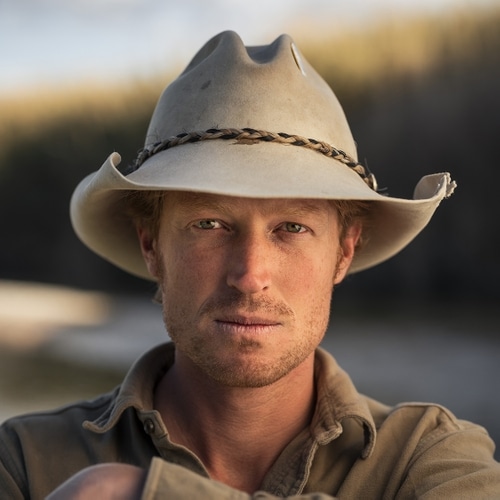
Ben Masters grew up in West Texas, studied wildlife biology at Texas A&M University, and spent four years working on a border ranch near Laredo. Masters is best known for UNBRANDED, a feature documentary on Netflix, in which he and three friends adopted 16 wild mustangs, trained them, and rode 3,000 miles from Mexico to Canada to inspire wild horse adoptions. He is a published author, a National Geographic photographer, cinematographer, and writer, and his work has received dozens of domestic and international awards including the Audience Award at Hot Docs International Film Festival, the People’s Choice Award at Banff Film Festival, and the Audience Award at Telluride Mountainfilm. Masters represents the interests of wildlife on 31.2 Million acres of federal public land as the Wildlife Management Chair of the BLM’s volunteer Wild Horse & Burro Advisory Board.
HILLARY PIERCE | Producer

Hillary Pierce is an Emmy Award-winning documentary producer based in Austin, Texas. She is a part of the producing team behind Keith Maitland’s dual 2016 documentaries TOWER and A SONG FOR YOU: THE AUSTIN CITY LIMITS STORY. Hillary began her documentary career at Maysles Films under the tutelage of Direct Cinema pioneer Albert Maysles and earned an MFA in Documentary Film at Wake Forest University. Her film THE ONE WHO BUILDS tells the story of the Muslim director of a refugee resettlement agency in the American South. TOWER won the Grand Jury Documentary Prize and Audience Award at SXSW in 2016, broadcast nationally on PBS’ Independent Lens in February 2017, was shortlisted for an Academy Award and won the 2018 Emmy for Outstanding Historical Documentary.
JAY KLEBERG | Producer & Character

Jay Kleberg is the Associate Director for Texas Parks and Wildlife Foundation. He is part of a team that conserves Texas’ most pristine lands to benefit wildlife and provide recreational opportunities to the public. He is a sixth generation Texan, born and raised on a working cattle ranch in South Texas. He is co-founder of a Brazilian-based Amazonian adventure travel company and conservation organization. Jay lived in El Paso for eight years working in cities along both sides of the US-Mexico border. He has experience with multi-day expeditions, having piloted a single-engine Cessna 5,500 miles from the Amazon to Texas in 2003, rode a mountain bike 2,700 miles along the Continental Divide Trail from the US- Mexico Border to Banff and paddled 264 miles of the San Marcos and Guadalupe Rivers as part of the Texas Water Safari. Jay lives in Austin with his wife and three daughters.
FILIPE DEANDRADE | Character
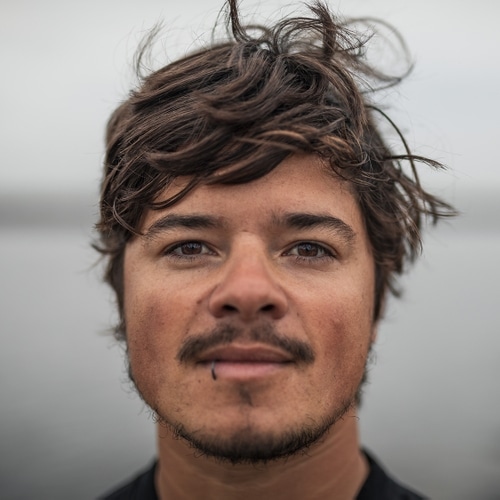
Filipe DeAndrade was born in Brazil, immigrated to the United States at age six, and grew up in Cleveland, Ohio. When he’s not in the field, he’s living in Florida out of a film production truck converted from a retired ambulance. Filipe is a Director for the Comfort Theory production company; the host for NatGeo Wild’s UNTAMED web series, and his love for wildlife is only equaled by his passion to tell their stories. Filipe is an Emmy nominated Associate Producer, has been nominated for 19 NY EMMYs, and has freelanced across the world as a Director of Photography.
HEATHER MACKEY | Character
Heather grew up in upstate New York near the Adirondack Mountains. After completing a BS in Ecology and Evolutionary Biology at Cornell University, she spent the next
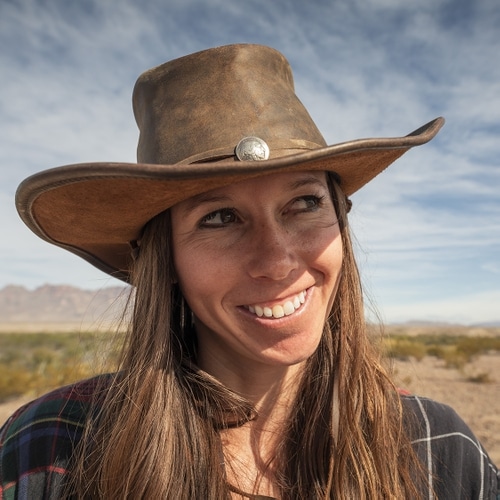
five years work as a field biologist. She has conducted conservation research in a variety of remote locations including Kodiak Island, Alaska where she led a two-month expedition to research the nesting ecology of the enigmatic Kittlitz’s Murrelet. She’s also worked in the Galapagos Islands, where she was part of a team studying Waved Albatross and Nazca Boobies as well as the Australian rainforest where she contributed to research on the behavior of the Satin Bowerbird. It wasn’t until she began her MS research at California State University Los Angeles that she discovered the wonderment of West Texas. She committed to field research in the hottest part of Big Bend National Park, during peak temperatures (100+ degrees), site unseen. Through her two seasons on the Rio Grande researching the impact of riparian restoration on the bird and butterfly communities she’s developed a deep appreciation for the wildlife and the people of West Texas.
AUSTIN ALVARADO | Character
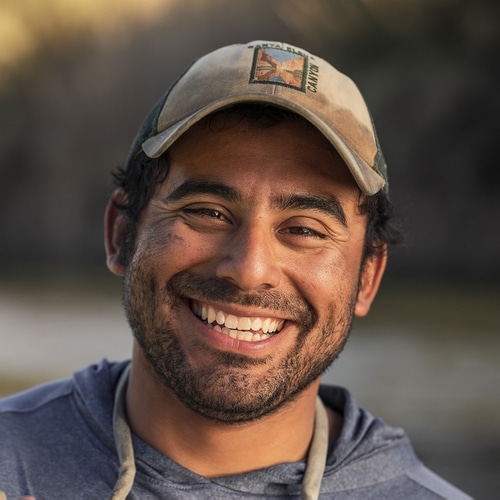
Austin was born in Austin, TX. He is a 1st generation Guatemalan American and spent his childhood going back and forth between Austin, TX and Guatemala. He chose to go to Texas A&M and while earning his B.S. in Recreation, Parks and Tourism Science, he spent summers working on cruise ships in the Mediterranean and river guiding on the Rio Grande in the Big Bend. Austin has paddled a number of rivers around the world but he continues to call the Rio Grande his home. He now is the Activities and River manager for the leading outfitter in Big Bend, Far Flung Outdoor Center. Austin has spent the past 5 years leading commercial trips down the Rio Grande, with the last 3 years as a permanent resident of the Big Bend area. Collectively, he has paddled over 200 miles of the Rio Grande in the Big Bend area.
PHILLIP BARIBEAU | Cinematographer
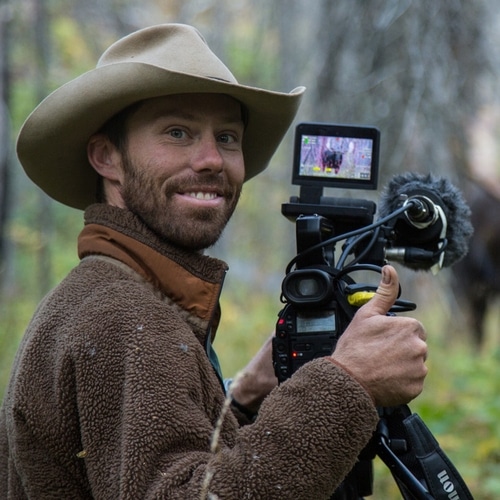
Phillip earned a degree in media and theatre arts from Montana State University. Following his passion for film, storytelling and adventure, he went to work in television and documentary filmmaking. His most credited broadcast series are DESTINATION EXTREME on National Geographic (Field Producer/DP/Editor), AX MEN on the History Channel (Field Producer/Camera Operator), MEATEATER on the Sportsman Channel (DP) and MOUNTAIN MEN on the History Channel (Camera Operator). In 2008, Phillip founded Implement Productions, based in Bozeman, MT. Phillip’s first feature length documentary, UNBRANDED (Director and DP), won the 2015 Audience Choice Award at Hot Docs International Film Festival, Telluride Mountainfilm, and the Banff Mountain Film Festival. He recently finished his next feature length documentary, CHARGED, THE EDUARDO GARCIA STORY (Director and DP). CHARGED was the opening night film for the Santa Barbara film festival in January 2017 and is currently playing festivals nationwide.
JOHN ALDRICH | Cinematographer/Editor
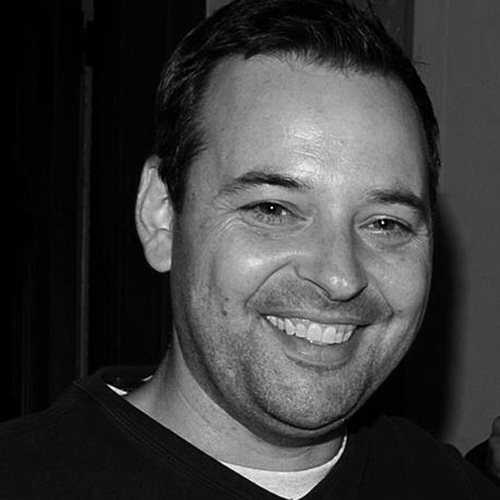 John Aldrich grew up in Florida, but was raised by Texans and got here as fast as he could, studying Film and Government at the University of Texas (’94). He received his Master’s in Documentary Filmmaking from the Documentary Institute at the University of Florida (’00) and lived and worked in the Washington, D.C. area for the next ten years (seven of them as a producer/editor for National Geographic Television) before returning to Texas. Since then, his work includes producing, editing and shooting the feature docs AN UNREAL DREAM: THE MICHAEL MORTON STORY (CNN, December 2013, SXSW Audience Award) and AUDUBON (PBS, April 2017) as well as shorts for GQ, The New Yorker, National Geographic, Yeti, Natalie Merchant and Bob Schneider.
John Aldrich grew up in Florida, but was raised by Texans and got here as fast as he could, studying Film and Government at the University of Texas (’94). He received his Master’s in Documentary Filmmaking from the Documentary Institute at the University of Florida (’00) and lived and worked in the Washington, D.C. area for the next ten years (seven of them as a producer/editor for National Geographic Television) before returning to Texas. Since then, his work includes producing, editing and shooting the feature docs AN UNREAL DREAM: THE MICHAEL MORTON STORY (CNN, December 2013, SXSW Audience Award) and AUDUBON (PBS, April 2017) as well as shorts for GQ, The New Yorker, National Geographic, Yeti, Natalie Merchant and Bob Schneider.
CINDY MEEHL | Executive Producer
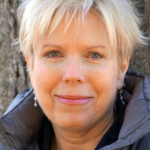
Cindy Meehl is the founder of Cedar Creek Productions. She directs and produces feature film documentaries. She recently directed her new film, The Dog Doc, which is premiering soon in 2019. She was the director and executive producer on BUCK. Meehl’s other films she executive produced are REWIND, THE RIVER AND THE WALL, TRAPPED, UNBRANDED, FOR THE BIRDS, and DOGS ON THE INSIDE.

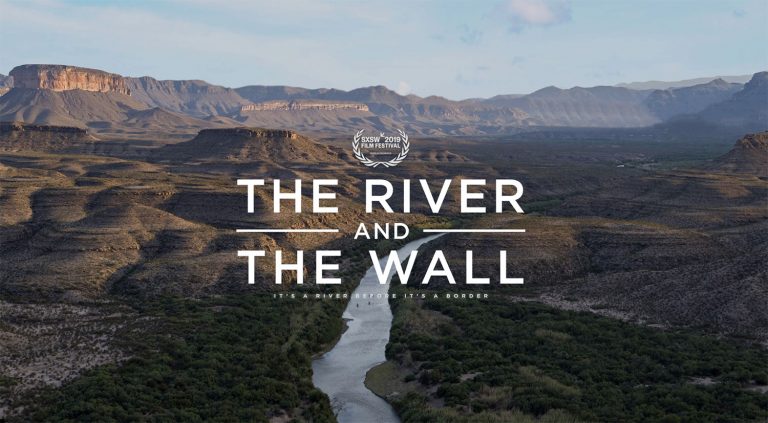
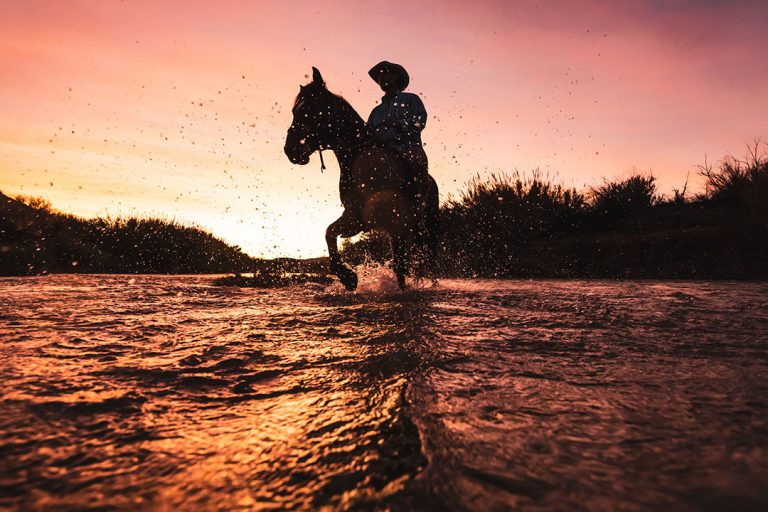

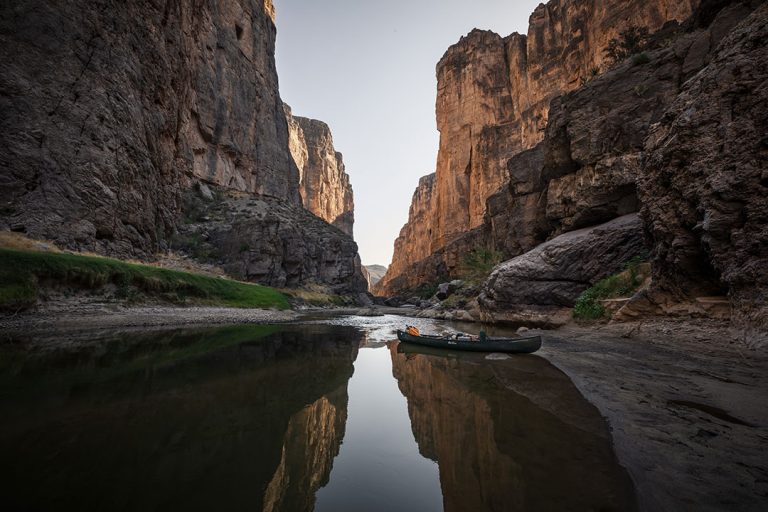

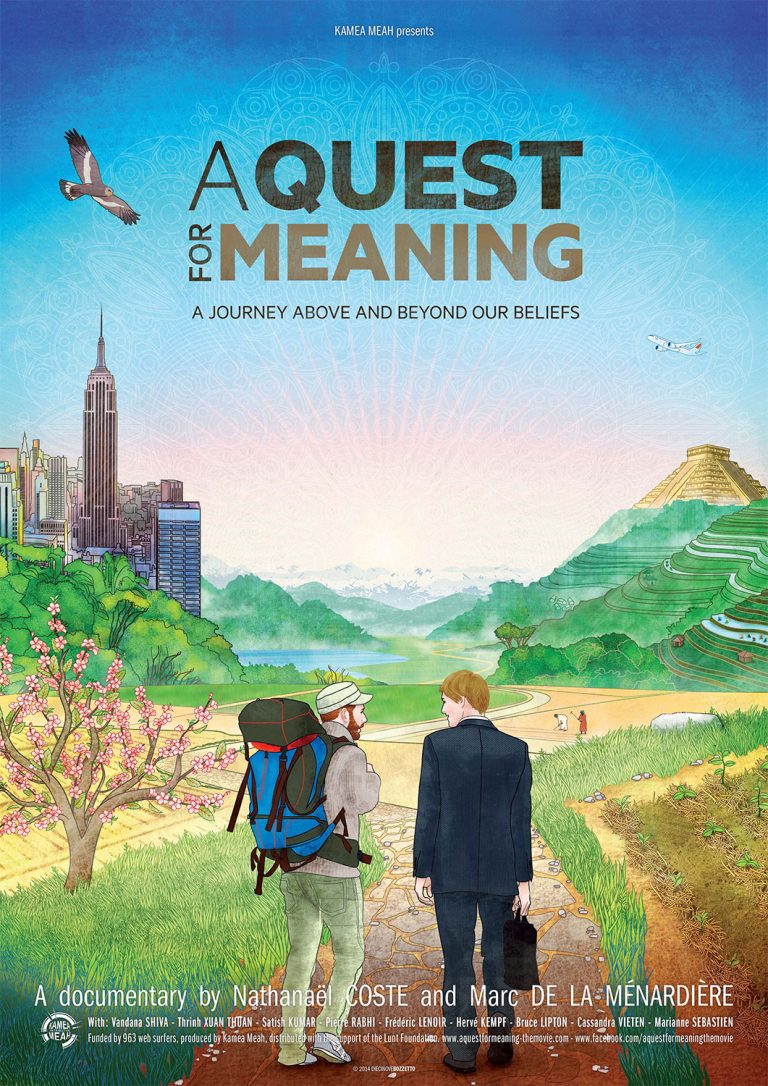
A Quest for Meaning
 Directors: Deborah Begel and David Lindblom
Directors: Deborah Begel and David Lindblom
Executive Producers: Dr. Johnnye Lewis and Chris Shuey
Original language : Navajo & English | Subtitles: Englis
TRT: 88m
This documentary is a four part meditation on the Navajo people’s problems with contaminated drinking water. Nearly one out of three people in the Navajo Nation struggle with this issue. Four Stories About Water opens with a waterfall of people who reveal the scope of water contamination problems on Navajo lands, from the health problems that were likely caused by uranium tailings left uncovered to the view of water as “a spiritual element” to the fact that 30% of the Navajo people don’t have access to safe water. «For us Diné people, if we treat water with respect and have spiritual faith, water will respect us. In this way, we will go forward in a balanced and harmonised life. » David Begay
The Human Element
For millennia, many civilizations thought that earth, air, fire, and water were the primary forces—the elements—of nature. Now, through new knowledge of how the world works, science has led us to realize that humanity itself has its own elemental power.
Earth scientists speak of natural tectonics. These are the forces cracking the planet’s crust with earthquakes and volcanoes. But humanity is a tectonic force, too. The combined power of our population, our technology, our survival needs, and our desire for affluence has reshaped the Earth as we know it.
James Balog—photographer, scientist, and filmmaker—recently dubbed the mechanisms of our impact “Human Tectonics.” In recognition of the widespread and long-lasting impact of humanity, the epoch of geologic time in which these impacts are taking place is known to science as the Anthropocene (pronounced “an’-throw-poe-scene”).
When the Anthropocene began is a matter of debate. Some scientists put it at 10,000 years ago, when agriculture became more prevalent than hunting and gathering. Many others peg it at 200 years ago, when the Industrial Revolution started spewing so much carbon dioxide and other gases into our air that the composition of our atmosphere changed. Still other scientists favor dating it to the first atomic bomb test: starting in 1945, the fallout from nuclear blasts laid down a worldwide layer of long-lived radioactivity on land and sea.
Human Tectonics produced the Anthropocene—and nearly everyone on Earth has benefited from the processes of the epoch. Increased industrial and agricultural capacity, improvements in water quality and medical care: these are big benefits to human life as a consequence of the Anthropocene. A dramatic increase in the human population during the past three centuries has resulted. The 20th century alone saw a fourfold increase in global population; as of 2018, there are 7.6 billion people on Earth. By the end of our current century, global population will likely reach 11 billion.
Ironically, that is both good news and bad news. Good news because people live at a generally higher level of health and comfort than our ancestors did. But it can also bring bad news for humanity and the environment around us.
Thus far, people have transformed more than 50 percent of the world’s land surface. 37 percent of all land area is now cultivated. Forests, deserts, and grasslands have been turned into farms and plantations, cities and suburbia. Populations of mammals, birds, fish, reptiles, and amphibians have plummeted 60 percent, on average, since 1970.
The Earth has warmed an average of 1.6 degrees F (1.0 degrees C) over the past 100 years. Some regions have seen two to three times that increase: the Arctic, for example, is warming four times as fast as the rest of the world. Storms, floods, and wildfires are more severe. Sea level is rising. Some of these impacts can be attributed to natural variation, but the science is crystal clear: most of these changes are a consequence of human impact.
The Anthropocene overturns centuries of Western philosophical tradition. It replaces the traditional idea that people are separate from nature with the realization that we are an integral part of it. As we reveal in our documentary film THE HUMAN ELEMENT, when people change the other elements, those elements in turn change us.
In THE HUMAN ELEMENT, Balog serves as our guide to the Anthropocene. The film takes us from Chesapeake Bay and the coal mines of Appalachia to the Rocky Mountains and the forests of California. We meet Americans on the front lines of climate change—and reveal what all this means for our children and our children’s children.
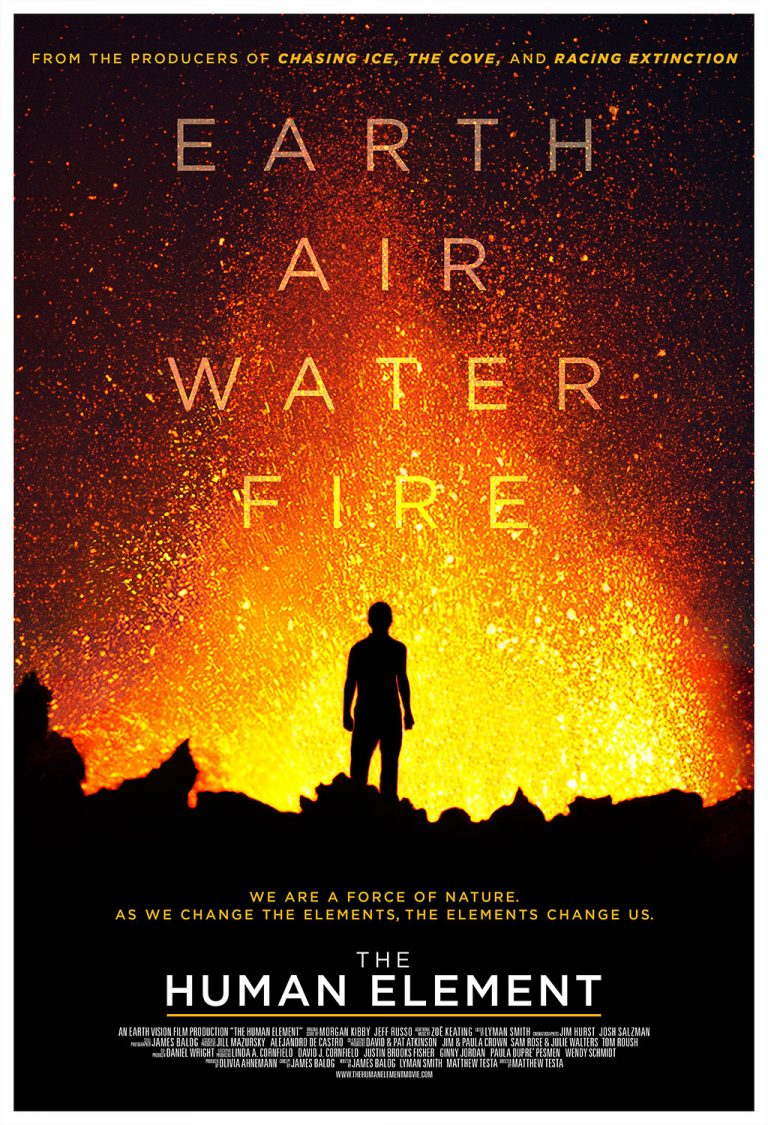


Four Stories About Water – D99’go T0 Baahane’
Producer,co-director, still photographer: Deborah Begel
Co-director, cinematographer, editor: David Lindblom
Executive Producers: Dr. Johnnye Lewis and Chris Shuey
Music: Michael Begay, Sharmita Benally, Heath Bergersen, Kip Powell, Lisa Powell and Andrew Thomas
Interviewers, Translators, Consultants: Sandy Ramone, Sarah Henio-Adeky, and Christine Samuel-Nakamura
Titles, Graphics: SandyKrolick
Ahéhee’– Thanks Also Navajo Nation Environmental Protection Agency, navajonationepa.org
And thanks to the National Institute of Environmental Health Sciences for support of the DiNEH Project.
TRT: 33m
This is a unique lm in so many ways. It breaks down the causes of water contamination all across Navajo lands. And it’s told in the voices of people who live with these dif culties 24/7. ‘Four Stories About Water’ is most valuable to a problem — and a people — so long overlooked.
— Robert Tohe, Environmental Justice Advocate, Flagstaff, Arizona
What the people are saying about their water problems is heartbreaking. This documentary will touch a lot of hearts and minds.
— Jeannie Magill, Originator and Co-producer, “Milking the Rhino”
I found ‘Four Stories About Water’ to be informative, moving, and tragic. Also, beautifully shot.
— Aaron Leventman, Producer, Moving Image Film Festival
A Deborah Begel production, in association with DiNEH Project of the University of New Mexico and Southwest Research and Information Center, with support from U.S. Environmental Protection Agency, Region 9. Additional support from the University of New Mexico’s School of Pharmacy, Northern New Mexico College and Canal Seis.
© 2012 Deborah Begel Productions
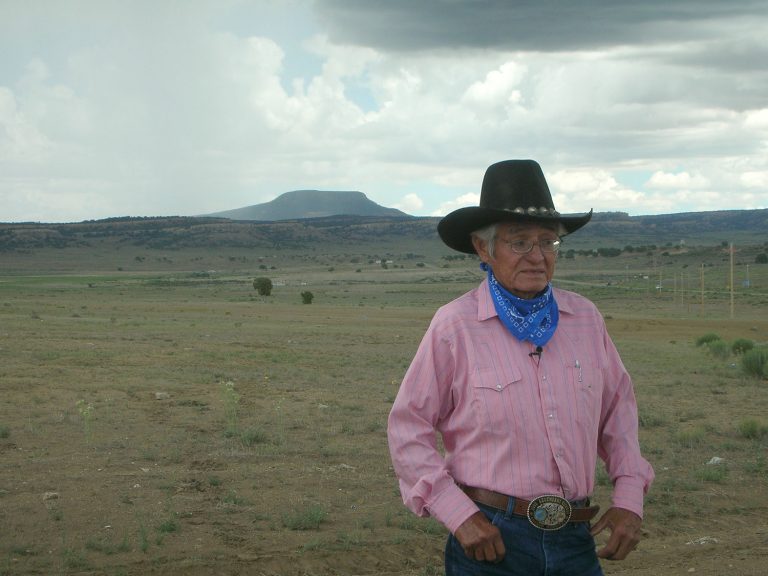

Walking Thunder
Directed by Santa Fe residents, Cyril Christo & Marie Wilkinson and narrated by their son Lysander. The filmmakers travel with their young son Lysander across East Africa, filming over the course of ten years as they observe the role of the elephant and its own rapidly changing reality. Walking Thunder presents a unique way of engaging a broad audience on these topics, telling a story through a family’s perspective and a child’s eyes. The directors have published photography books and articles, and have lectured and exhibited artwork on the subject internationally- but they see documentary as a way to engage audiences on a wider scale and with greater emotional impact.
TRT: 94 m
Release Year: 2018
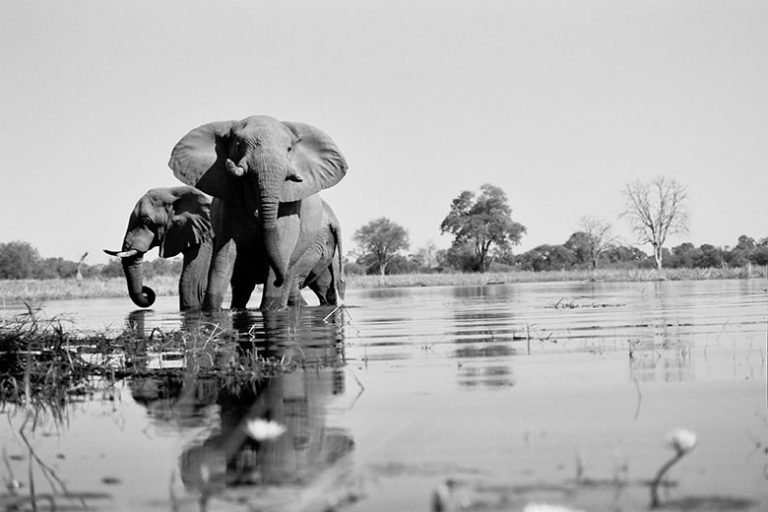

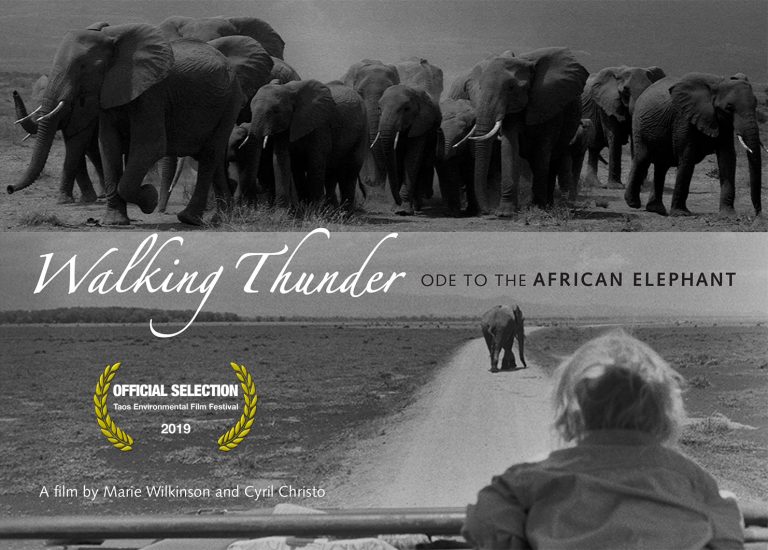
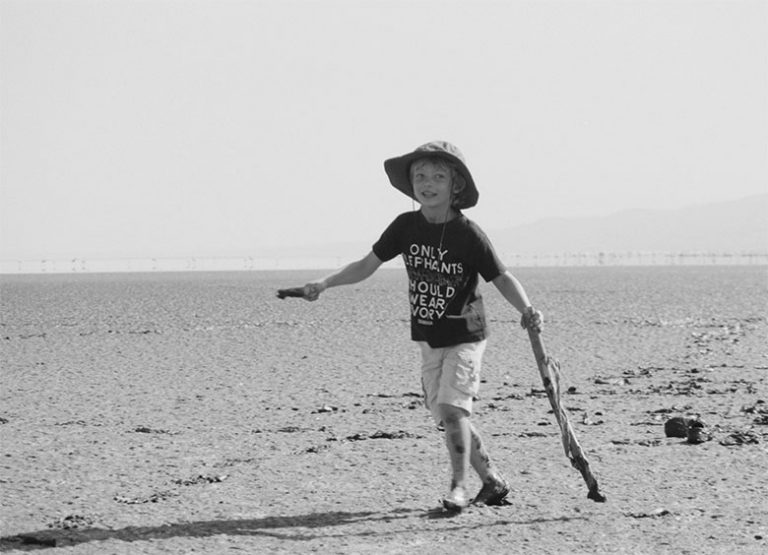
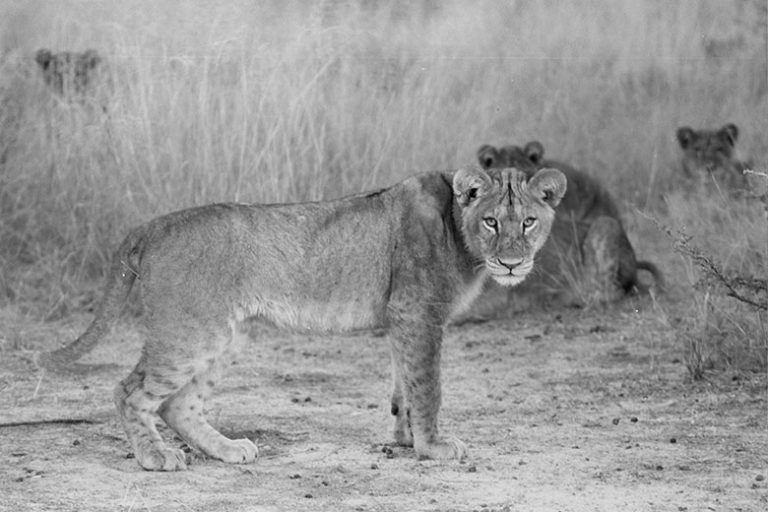

Too Precious to Mine
Director: Justin Clifton
TRT: 10m
The Grand Canyon is an irreplaceable natural treasure that draws over 5.5 million visitors to the park each year. Yet, irresponsibly operated uranium mines located on federal public land just miles from the North and South Rims threatens to permanently pollute the Grand Canyon landscape and the greater Colorado River.
I Am Nature
 Directed by: Elke Duerr
Directed by: Elke Duerr
TRT: 8m
Elke Duerr, who divides her time between New Mexico, Montana and Europe. I am nature: You are human nature, nature in human form. You humans are the outside Earth, animated Earth. What befall one of us, befalls us all. Now the time has come for reciprocity, for caring for me and yourselves, for giving and receiving, for healing all life on this planet.
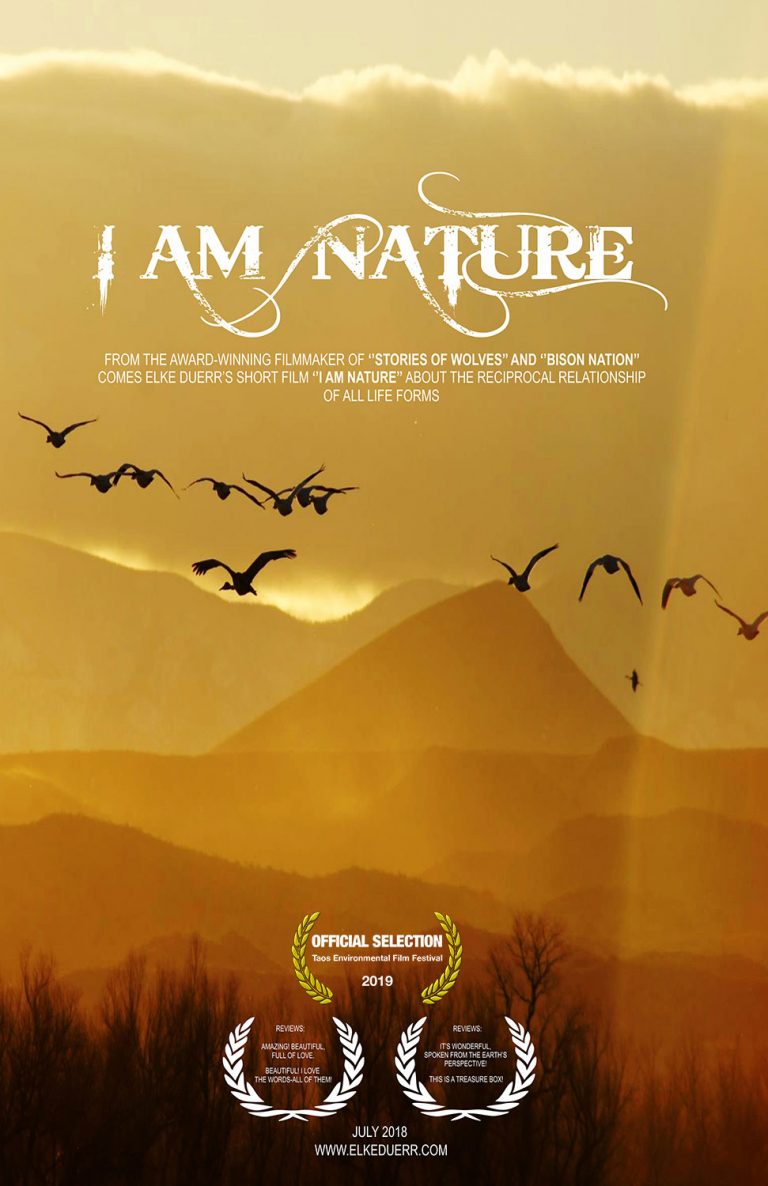

Tale of a Toxic Nation
TRT: 13m
It is the story of a nation rich in resources but weak in political influence. The Navajo Reservation has been left with over 500 abandoned uranium mines; toxic surroundings and an impossible clean up. The story has never been more relevant under an administration threatening to restart uranium mining.

Anthem for the Amazon
Anthem for the Amazon, Amazon Aid Foundation, TRT: 5m
Voices for the Amazon, Amazon Aid Foundation, TRT: 6m
Anthem for the Amazon is a collaboration to unite the world in a compelling call to action to save the world’s greatest rainforest through the universal language of music. 500 children from 50 different countries around the world came together to sing this global anthem and stand up for the Amazon rainforest. We hope you’ll sing along with them.
Hibaksha Remembers
Directed by: Jean E. Stevens
TRT: 7m
Hibaksha Remembers directed by Jean E Stevens. A young teenage poetess witnessed the world’s first nuclear attack on a civilian population. The Hiroshima Hibaksha (nuclear attack victim) used poetic language to describe that morning of August 6, 1945 at 8:15 AM. The narration was recorded on the campus of the University of California in 1986 when the director of this film was in art school. The narrator, a Japanese student, read the young Hibaksha’s account. The Japanese student and the music are now unknown.

